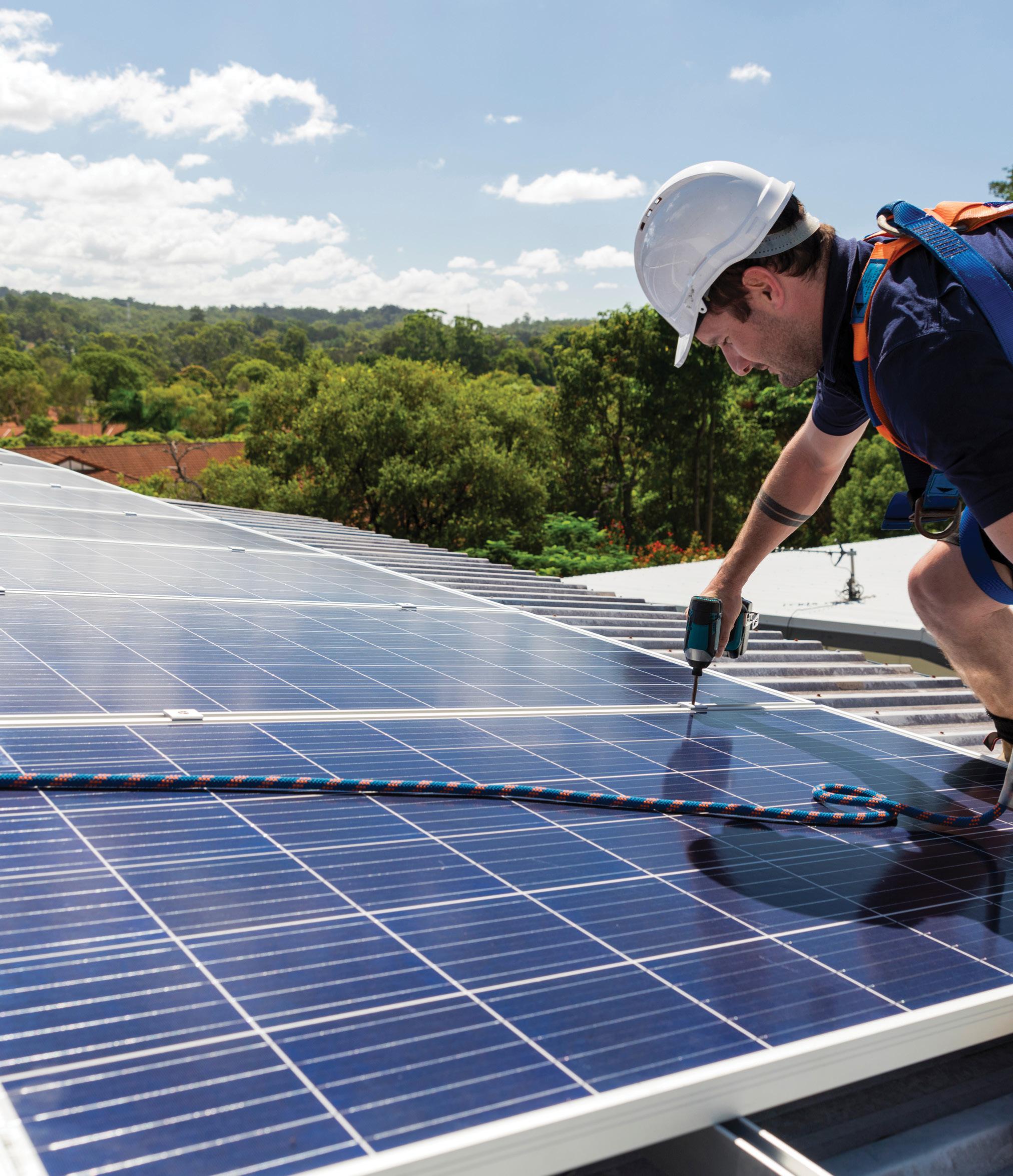
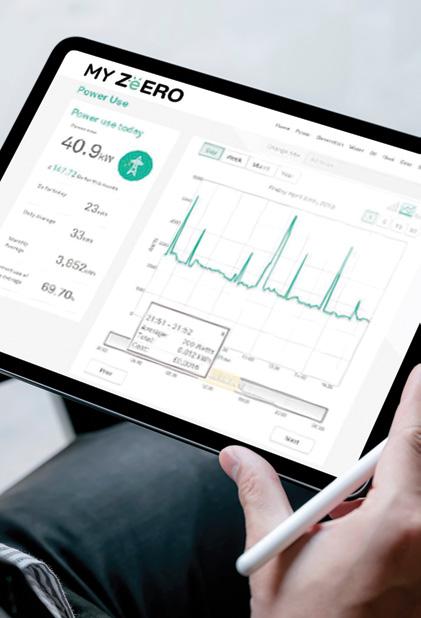
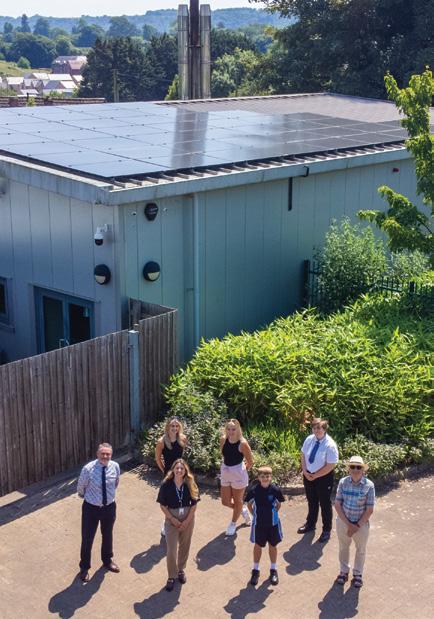
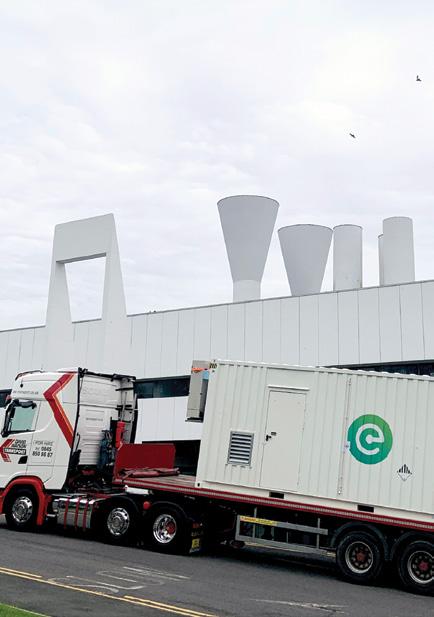

Power Quality Issues – Part 5 – Reactive Power and Power Factor 16 Rinnai delivers hot water at Scarborough Care Home 23 Keeping Commercial Heating Systems Clean 24 Do you know how much energy you waste? 20 National Grid funds first solar panel installation at Gloucs school 10 Using battery energy storage to power the EV transition 28 www.energymanagermagazine.co.uk MAXIMIZING SAVINGS: Powering Businesses with Solar PV Arrays and Battery Storage See page 16 JULY/AUGUST 2023 INSIDE THIS ISSUE:

For over 20 years we’ve been helping our customers manage and procure energy, cut waste, save money and reduce carbon with no upfront cost. Contact us today to see how we can reduce your energy costs by up to 30%. 020 3813 1550 eenergy.com Take back control of your energy.
JULY/AUGUST 2023
PUBLISHER: Ralph Scrivens ralph@ energymanagermagazine.co.uk
PRODUCTION: Sarah Daviner sarah@ energymanagermagazine.co.uk
ACCOUNTS: accounts@ energymanagermagazine.co.uk
PRINT: Mixam Print
ENERGY MANAGER MAGAZINE
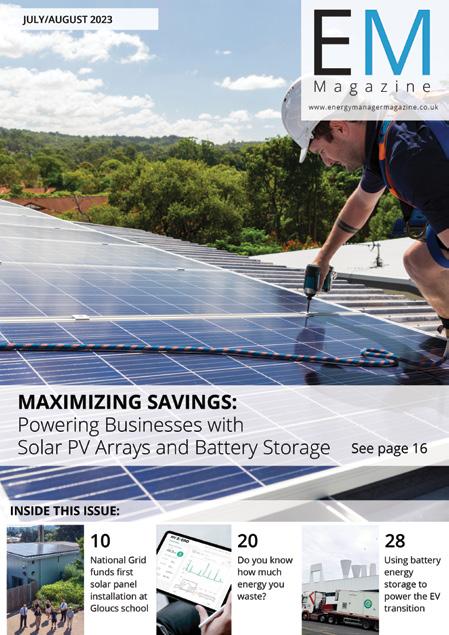
is published 10 times a year by Energy Manager. www.energymanagermagazine.co.uk
42 Wymington Park, Rushden, Northants, NN10 9JP Tel: 01933 316931
Email: mail@ energymanagermagazine.co.uk
REGISTRATION: Qualifying readers receive Energy Manager free of charge. The annual subscription rate is £80 in the UK, £95 for mainland Europe and £115 for the rest of the world.
Single copies £10.
Some manufacturers and suppliers have made a contribution toward the cost of reproducing some photographs in Energy Manager.

PAPER USED TO PRODUCE THIS MAGAZINE IS SOURCED FROM SUSTAINABLE FORESTS.
Please Note:
No part of this publication may be reproduced by any means without prior permission from the publishers. The publishers do not accept any responsibility for, or necessarily agree with, any views expressed in articles, letters or supplied advertisements.

All contents © Energy Manager Magazine 2023
ISSN 2057-5912 (Print)
ISSN 2057-5920 (Online)
INSIDE ENERGY MANAGER MAGAZINE • JULY/AUGUST 2023 3 MAXIMIZING SAVINGS: Powering Businesses with Solar PV Arrays and Battery Storage FRONT COVER STORY: See page 16 4 News 12 Opinion 14 Monitoring & Metering 20 Energy Management 26 Energy Storage 29 Steam Boilers 30 Energy Networks 32 CHP 33 Heating 34 Heat Pumps 35 Lighting 36 Renewable Energy 37 Water Management 38 Recruitment 39 Training
Energy partnership to slash carbon emissions by 20% across public buildings in Medway
SSE Energy Solutions has delivered a project that is targeting a 20% reduction in carbon emissions across 11 major public buildings in South East England as part of an ambitious energy partnership with Medway Council.
The forecasted savings will reduce emissions by 476.5 tons of CO2, the equivalent of taking more than 2 million miles of car journeys off the roads every year.
The partnership has seen vital community assets such as libraries, theatres and leisure centres undergo a range of energy-reducing measures including the installation of rooftop solar, energy storage systems, airsource heat pumps, demand controlled ventilation, and LED lighting. The work will deliver cost-savings of 35% for the local authority, based on 2019 rates. All of the libraries have had oil boilers and gas heaters removed, with Daikin Heat Pumps installed.
Additionally, waterless urinals and ultra-low flow showers have been
installed in some buildings to help reduce water usage by up to 10%.
SSE has also supported the council to install 20 EV charging points at its HQ.
The retrofits, worth an estimated £3.2m, represent a significant step towards Medway Council’s ambitions of achieving net zero carbon emissions by 2050 as their operational buildings (heating and electricity) currently account for 60% of total emissions
Medway Park Sports Centre and Gun Wharf, together account for 69% of the total energy consumed by the 11 buildings. A Solar and Energy Storage System installed by SSE Energy Solutions at the Sports Centre means it can go fully off grid for 4-to-5 hours a day.
The buildings upgraded as part of this programme will form the foundation of Medway Council’s Smart City project. Nine of the eleven buildings will be fitted with Smart Building upgrades, equipped with an Internet-of-Things embedded controller and server platform that delivers

integrated control and supervision capabilities. The accompanying Building Management System will monitor all heating, ventilation and air-conditioning (HVAC) services, ensuring the building operates at maximum efficiency.
Cllr Simon Curry, Medway Council’s Portfolio Holder for Climate Change, said:
“We are committed to achieving net zero carbon in Medway by 2050 and this important project will help us reach this goal. We are working hard to make significant carbon savings and this second phase of the project will help us to achieve this. I am pleased to be working alongside SSE and we will work with all our local sup-pliers and contractors to support local businesses and achieve net zero together.”
www.sseenergysolutions.co.uk
CONSULTATION
Leading electric vehicle (EV) smart charging provider, ev.energy, has launched “Unlocking Industry Barriers to Providing Vehicle-toEverything (V2X) Flexibility”, a white paper delving into the future of EV charging and its significance in creating a sustainable energy grid and promoting cleaner air quality.
Drawing upon over 40 hours of industry expert interviews from the UK, EU, and US, as well as consumer surveys, industry reports, and data analysis, ev.energy presents a clear roadmap towards the implementation of smart bi-directional charging, enabling EVs to support the energy grid. The white paper functions to analyse the obstacles hindering V2X energy flexibility. By aligning industry perspectives, ev.energy’s white paper offers a unified approach to address these challenges and unlock the full potential of V2X technology.
The white paper forms part of ev.energy’s V2X-Flex project in partnership with Energy Systems Catapult. The V2X-Flex project, part of the V2X Innovation Programme, is funded by the Department for Energy Security and Net Zero (DESNZ), delivered by Innovate-UK. V2X is part of the up to £65m Flexibility Innovation Programme, funded from the £1 billion DESNZ Net Zero Innovation Portfolio.
The white paper underscores the importance of consumer acceptance in realising the potential of V2X technology. It identifies key challenges in the consumer’s V2X journey:
• Facilitating attractive compensation models for consumers participating in V2X programmes.
• Ensuring the availability of affordable and compatible charging equipment for V2X capabilities.
• Promoting safe battery and vehicle operations during bi-
directional energy flows.
• Enhancing the user experience by providing seamless integration and intuitive controls for V2X functionalities.
• Establishing trust and understanding among consumers regarding the benefits and technical aspects of V2X technology.
To overcome these barriers, ev.energy calls for collaboration among automakers, charger manufacturers, energy management platforms, utilities, regulators, and government entities.
The ev.energy white paper on unlocking industry barriers to providing V2X energy flexibility is available to download at https://www.ev.energy/ business/v2x-white-paper
For more information about ev.energy and its innovative EV charging solutions, visit https://www.ev.energy/

ENERGY MANAGER MAGAZINE • JULY/AUGUST 2023 NEWS 4
EV.ENERGY SETS OUT EIGHT-STEP ROADMAP TO “UNLOCKING BARRIERS TO V2X ENERGY FLEXIBILITY” AFTER GLOBAL INDUSTRY










 ...RELY ON POWERSTAR
...RELY ON POWERSTAR
EUROPEAN HEAT PUMP ROLLOUT
SET TO TURBOCHARGE WITH OVER 45 MILLION SET TO BE INSTALLED BY 2030
The European Heat Pump Association’s latest market report showcases the positive impact heat pumps are having across Europe to mitigate emissions and grow European economies. We welcome these figures and believe the UK can afford to be equally ambitious provided the Government takes swift and decisive action to support the market.

Across Europe, rapid heat pump rollout has meant the 19.75 million systems installed across the continent has avoided 52.3Mt CO2e emissions per year, roughly the entire annual emissions of Greece.
The report also shows that heat pump systems are versatile, working efficiently even in colder climates.
In addition, the European heat pump industry is now employing over 160,000 people, with around 37% in manufacturing. These insights demonstrate how the transition to low carbon heating is supporting growth in the future workforce.
The UK is showing progress and our figures for the first half of 2023 project a growth in heat pump sales by around 10% based on 2022 figures. However, the UK is still falling behind, with one of the lowest heat pump penetration rates across Europe despite high forecasted growth.
Commenting on this, Charlotte Lee, Chief Executive of the Heat Pump Association said: “Whilst heat pumps sales have grown year on year in the UK, total sales when compared with our European counterparts are low. We believe the UK Government’s projected deployment target of 600,000 heat pumps installations per year by 2028 remains achievable provided it moves swiftly and decisively to introduce the Future Homes Standard, provide early clarity of a date for the full phase out of 100% fossil fuel boilers, and takes steps to reduce the price of electricity. Our members are clear that the price of electricity relative to gas is a critical factor, and we support the EHPA’s view that electricity prices should be no more than twice those of gas.”
The report clearly shows a statistically significant correlation between decreases to the ratio of gas to electricity prices and increases to heat pump sales. For example, in 2022, the ratio of electricity to gas prices in the Netherlands decreased significantly compared to 2021 resulting in the heat pump market almost doubling.
Considering the importance of energy prices, it is concerning that the UK has one of the highest ratios of electricity to gas
prices out of 27 countries analysed in the report.
The ratio from the July 2023 price cap, 4.01, is far higher than the ratio of 2 that the EHPA see as necessary to incentivise consumer demand.
Within the Powering Up Britain announcements, the Government confirmed that it would set out plans during 2023-2024 to rebalance gas and electricity costs with the aim of making electricity bills cheaper to support the speeding up of electrification for households and businesses. We fully support this commitment and will be working closely with the Government over the coming months to support thinking in this space. We are calling on them to act swiftly to provide industry with the clarity and confidence needed to invest and grow the market.
The Heat Pump Association are members of the EHPA.

Read more here: https://www.ehpa. org/press_releases/market-report-2023/
NEW GUIDE EXPLAINS 3 STEPS TO IMPROVE HEAT NETWORK EFFICIENCY
Heat network specialist Switch2 Energy has published a free guide to provide operators with realtime tips and advice on improving the efficiency of communal heating schemes – assisting them to tackle the triple challenge of cost, carbon and compliance.
The heat network efficiency guide explains the 3 steps operators can take to maximise performance of the UK’s 17,500 existing schemes, many of which perform at low efficiency levels.
Switch2 calculates that increasing efficiency by 30% on a poor performing heat network (serving 300 properties) could save more than £110,000 and 298 tonnes of CO2 per year. That’s based on gas input costs of 8p per KWh.
“Many existing communal heating schemes are languishing at poor 35 to 40% efficiency levels”, said Richard Harrison, CEO of Switch2 Energy. “Our guide explains how utilising data from the network to inform operations and
maintenance methods can raise efficiency by as much as 30 to 40%. This increase in efficiency translates into reduced running costs, lower residents’ bills and an increased ability to meet decarbonisation targets.
“Taking a reactive approach to maintenance does not work. Heat network operators must proactively manage their maintenance and make use of innovation and data insights to transform efficiency and comply with major new regulatory and technical standards.
“In the guide, we focus on the practical measures that can reduce both energy and operational waste – for better cost and carbon performance. We also profile some of the private developers and housing associations who are using data insights and innovation to drive efficiency.”
Download the free guide: https://content. switch2.co.uk/your-complete-guideto-tackling-the-heat-network-triplechallenge-cost-carbon-compliance

ENERGY MANAGER MAGAZINE • JULY/AUGUST 2023 NEWS 6
Prefect products are designed specifically for accommodation where the room occupant is not directly responsible for paying the heating bills. Tamper-proof, robust and always striving to use less energy, our systems will improve your energy management and efficiency.


PrefectControls.com THIS IS BEYOND
CONTROL Central control Local control * Savings are dependent on current control methods, infrastructure, location and profiles adopted.
YOUR
CENTRAL CONTROL All ecostat2 features + Secure portal access + Humidity + Light + Sound pressure + CO 2 + Water heating + Leak detection • up to 40% savings * LOCAL CONTROL • Room temperature • Setback, Boost & Frost • User adjustment • Open window • Absense detection • Tamper-proof • Programmable • Electric or wet systems • up to 30% savings * Scan for product comparison
CUBE YEAR 1 RESULTS DEMONSTRATE THAT THE UK’S OFFICE
SAVING 3 MILLION TONNES OF
AND £3.8BN ANNUALLY
Thirty percent of energy used in office buildings is wasted. The CUBE Competition is helping to change that. It is the UK’s first initiative to tackle the dual challenges of energy efficiency improvement and occupier engagement in commercial buildings through gamification, and has helped buildings reduce energy consumption by up to 39% - collectively enough to power 5,000 homes for a year. It uses an innovative approach to bring landlords, building managers and occupiers together, mobilising them to reduce energy consumption through changing behaviour – the logical first step to net zero.
The inaugural year of the competition featured 30 participating buildings, ranging from grade II listed buildings to iconic skyscrapers like the “Walkie-Talkie” and the “Cheesegrater”. At its awards ceremony today, hosted in partnership with Nuveen Real Estate and BNP Paribas Real Estate at 70 St Mary’s Axe, it unveiled a total saving of over 6,087 tonnes of CO2 across 540,895 sqm of commercial space, collectively saving its participants £8m in energy costs.
Applying these savings to the circa 860 million sq ft of office space across England, for example, the UK, a staggering £3.8bn a year in energy costs could be saved, not to mention nearly 3 million tonnes in carbon reduction.
At the event, awards were given for buildings in the Historical data category, where they were challenged to compete against their own past energy consumption.

The winning building at 40 Holborn Viaduct, owned by Nuveen and managed by BNP Paribas Real Estate slashed 38.8% of its energy. The iconic 20 Fenchurch Street owned by H Properties and managed by Savills snagged second place ,while XLB’s The Tootal Buildings managed by Ashdown Phillips came in third place.
Awards were also given in the AV league, which focuses on newly built or refurbished buildings, and which looks at absolute value, whereby building are given an absolute energy budget based on UK Green Building Council Office Energy Intensity Targets. The Frames owned by Workspace came out top, followed by RO’s GNR8 and The Howard de Walden’s Estate’s head office at 23 Queen Anne Street.
With the first year of the competition concluding, the results produced some interesting findings. The expectation was that large buildings would do significantly better, but medium-sized buildings
stole the spotlight saving 18% annually, compared to 12% for large sized buildings.
Another surprising result was the BREEAM-certified buildings still had a large capacity for energy savings, with a substantial average energy saving of 22%. In all, the average energy intensity of CUBE buildings before the competition was 262 kWh/m², but after the competition, this reduced considerably to 215 kWh/ m². While significant, buildings across the UK will need to continue their efforts to meet UK Green Building Office Intensity Targets of 90 kWh/m2 by 2030.
Finally, CUBE can reveal that buildings in Manchester achieved outstanding energy savings, with an average of around 20%. One Victorian building in Manchester stands out by making a significant contribution to these impressive savings, highlighting the potential for energy-efficient transformations even in Grade II listed buildings. www.cubecompetition.co.uk
‘Balancing cost and carbon goals in the NHS’ is the title of the new report – designed to help Trusts navigate an affordable pathway towards decarbonisation and achieve their net zero 2040 goals. The free guide explains why carbon reduction is a key opportunity to stretch tight NHS budgets much further, while
delivering on challenging net zero targets. The report explores:
• Steps that can be taken to manage energy costs in a tough environment
• The technologies that can deliver both cost and carbon reductions

• Public and private sector funding options
Download the guide to cost-effective net zero delivery in the NHS – https:// www.centricabusinesssolutions. com/knowledge-centre/reportsand-whitepapers/balancing-costand-carbon-goals-nhs-trusts

ENERGY MANAGER MAGAZINE • JULY/AUGUST 2023 NEWS 8
MARKET COULD BE
CARBON
How can NHS trusts find a cost-effective path to net zero?
A new guide to cost-effective net zero delivery in the NHS has been published by Centrica Business Solutions.
Energy Managers across the UK are switching on to the power of battery energy storage.















Battery energy storage systems can be used to store and provide power as and when it’s needed, forming part of an overall site’s microgrid. Maximise solar generation, manage peak loads and overcome capacity constraints with a system from Connected Energy.




Download our latest guide to find out how battery energy storage can help to deliver smarter energy solutions and support decarbonisation measures. connected-energy.co.uk/smart-buildings








Powering the buildings of the future How battery energy storage can help deliver smarter energy solutions for facilities management connected-energy.co.uk
National Grid funds first solar panel installation at Gloucestershire school
Aschool in Gloucestershire has become the first to install solar panels with funding from National Grid Electricity Distribution, as part of the company’s pledge to drive sustainability and promote net zero in local communities. Rednock School in Dursley, Gloucestershire, has benefitted from National Grid’s solar PV fund which was established in its RIIO-ED2 distribution Business Plan.
National Grid is the distribution network operator for the Midlands, South West and South Wales, looking after the network of overhead lines, underground cables and substations that delivers electricity across the region.
The Gloucestershire scheme is part of the company’s Business Plan commitment to ‘build decarbonised communities and local energy schemes by providing £540,000 of shareholder-funded support each year to install solar PV on schools in areas of high economic deprivation’.
This commitment was reinforced in the company’s recently updated Social Contract, which aims to add value to the environment and to the lives of customers and colleagues.
The 19kW solar panel system at Rednock School is the first project to be delivered and will create a blueprint for similar schemes at schools across National Grid’s distribution area. National Grid provided £10,000 of funding for the solar PV system

and £2,000 towards its maintenance. The school also provided additional funding to expand the size of the installation.
The project was carried out in partnership with key local stakeholders, including school staff and governors, as well as a local ecologist who is monitoring biodiversity net gain and carbon levels. This will help both the school and the local community to become more sustainable.
Ellie Patey, Social Obligations Officer at National Grid said: “This is a landmark project for National Grid as we increase our support for local community projects by helping them to decarbonise. At National Grid, we’re committed to delivering locallytailored solutions which is why the unique insight of local stakeholders, who have a close connection to the community, is so invaluable. This project has helped to shape the model that will be scaled up across our network over the next five years as we deliver on our RIIO-ED2 commitments.
“We hope the project will support Rednock School to become more sustainable, as well as being a seed point for wider community sustainability.”
Alongside the solar panels, National Grid is also delivering STEM (science, technology, engineering and maths) outreach and education activities at the school to promote net zero, the benefits of renewable energy and careers in STEM.
Headteacher David Alexander said: “Rednock School is pleased to play a part as a pilot project in National Grid’s support for net zero communities. Not only will we benefit from reduced energy bills and a more sustainable school environment, but students are also gaining the skills and understanding needed for 21st century living. As an important part of the local community, the school will be helping to meet net zero challenges.”
https://www.nationalgrid.co.uk/
Nottingham Trent University launches pioneering Net Zero Carbon Supplier Tool to HE sector
Nottingham Trent University (NTU) has developed a pioneering tool to enable higher education institutions to meet Net Zero Carbon targets.
Developed in-house and in collaboration with NETpositive Futures, the Net Zero Carbon Supplier Tool not only provides an institution with more accurate supply chain (scope 3) carbon emissions data but also proactively targets and influences its suppliers to reduce their own carbon emissions.
Following a successful pilot with NTU’s own suppliers, the Tool has been rolled out to five universities ahead of the official launch in September; University of Birmingham, University of Manchester,
University of Lancaster, University of Bath and Anglia Ruskin University.
The Tool was developed in response to two issues:
The need to better calculate supply chain emissions as existing methodology didn’t reflect sustainable decisions put in place, or a growing institution
• The need to influence and educate suppliers to reduce their own carbon emissions in a way that captured the volume of suppliers as well as the size (the majority being SMEs)
The resulting Net Zero Carbon Supplier Tool addresses the first issue by producing more accurate carbon emissions data.

In addition, suppliers are provided with
an estimated carbon footprint and a bespoke carbon reduction plan free of charge. Where businesses supply multiple universities, their profile will be shared with those institutions. Therefore, the Tool not only helps HE institutions reduce their carbon emissions but helps their suppliers in turn to work towards meeting the UK’s target to reduce carbon emissions by half by 2030. For institutions looking to find out more about the Net Zero Carbon Supplier Tool they can register to attend the official launch Webinar on 20 September. https://www.eauc.org.uk/shop/ mms_single_event.php?event_id=8468
ENERGY MANAGER MAGAZINE • JULY/AUGUST 2023 NEWS 10
Pictured are Deputy Headteacher Steve White (front, left), Ellie Patey, Social Obligations Officer at National Grid (front, second from left) and David Martin, School Governor, with students from Rednock School.
Spirax Sarco Launches Innovative Range of Insulation Jackets
Spirax Sarco is pleased to announce the launch of its advanced range of insulation jackets. Designed to optimise energy efficiency and reduce heat loss in industrial processes, these innovative jackets represent a significant advancement in insulation capability. The new range of insulation jackets from Spirax Sarco is specifically engineered to meet the evolving needs of various industries, including oil and gas, chemical, food and beverage, pharmaceutical, and more. These jackets provide superior quality and thermal insulation, helping businesses achieve substantial energy savings while promoting environmental sustainability.
Key Features and Benefits:
1. Unparalleled Thermal Efficiency - Spirax Sarco's insulation jackets employ cuttingedge materials and advanced construction techniques to deliver exceptional thermal efficiency. They effectively minimise heat loss and prevent energy wastage, ensuring optimum performance and
cost savings for industrial operations.
2. Customised Design - Each insulation jacket is tailor-made to fit specific equipment and components, guaranteeing a precise fit. This customisation enhances the insulation's effectiveness by eliminating gaps and ensuring comprehensive coverage, thereby maximising energy savings.
3. Easy Installation and Maintenance - The jackets are designed for hasslefree installation and maintenance. Their user-friendly features allow for quick and straightforward application, reducing downtime and labour costs. Furthermore, periodic maintenance is effortless, ensuring long-term insulation performance without disrupting operations.
4. Robust and Durable - Spirax Sarco's insulation jackets are crafted using high-quality, durable materials that withstand extreme temperatures, harsh conditions, and wear and tear. Their exceptional durability ensures
a prolonged lifespan, offering a costeffective solution that withstands the rigors of industrial environments.
5. Safety and Compliance - The insulation jackets meet and exceed industry safety standards. They are resistant to fire, chemicals, and moisture, minimising risks and ensuring compliance with regulatory requirements. By providing a secure thermal barrier, the jackets enhance workplace safety and protect personnel and equipment.
Spirax Sarco is committed to providing holistic solutions for energy optimisation and sustainability. The introduction of the new range of insulation jackets aligns with the company's dedication to helping industries reduce their environmental footprint, lower energy consumption, and enhance operational efficiency.
To learn more about Spirax Sarco's new range of insulation jackets and how they can revolutionise industrial energy efficiency, please visit sxscom.uk/insulation
EYEBRIGHT STRENGTHENS RELATIONSHIPS WITH ENERGY MANAGERS
Utilities management experts, eyebright has enhanced their technology platform, industryexpertise, compliance advice, and procurement services to align with the needs of energy managers.
Established in 2009, the consultancy firm supports energy managers to minimise energy overheads while strengthening their sustainability credentials.

In the last 24 months, eyebright has saved customers including SMEs and multi-site PLCs, £83million through effective procurement strategies.
To support its expansion strategy and best serve energy managers, Tim Partridge has been appointed Director of Energy Markets.
With more than 20 years’ experience, including time spent at SSE and E.On, he will strengthen eyebright’s ability to innovate products for large energy intense businesses by giving them access to wholesale markets.
Managing Director Jamie Newall said: “We are planning for huge growth and with that has come some important new team updates.
“Tim is a recognised expert industry commentator with a strong analytical understanding of the energy market and excellent relationships with suppliers.
“His addition to our rapidly expanding team is a real coup and allows us to provide further support energy managers with a complex range of procurement and management needs.
“These are exciting times for the business as we continue delivering the best solutions available for our customers.”
Through an effective sustainable energy management strategy, eyebright expects to remove over 19 million tons of CO2e from the environment over the next 36 months. That’s the equivalent of over 400 UK SME businesses becoming carbon neutral. eyebright is actively seeking to collaborate with energy managers on carbon reduction strategies and reporting solutions.
New recruit Tim Partridge said: “The company has grown from strength to strength, and there are huge opportunities going forward.
“I hope my industry experience will provide clients with additional support, market intelligence and enhance the range of services we offer.”
eyebright predict its head count to double over the next 36 months, having already
expanded its water auditing, climate change levy and energy procurement divisions.
Established last year, the water auditing department has achieved refunds and savings for schools in the north-west of England of over £450,000 and is forecast to save schools over £2 million over the next 12 months.
To further support its expansion strategy, eyebright has seen the appointment of new Commercial Director, Chris Quinn, and the promotion of Jon Reeves to become Head of Energy Solutions and Jo Buckley to Head of Supplier Relationships. www.eyebrightutilities.co.uk

NEWS ENERGY MANAGER MAGAZINE • JULY/AUGUST 2023 11
HEAT-AS-A-SERVICE: A NEW FRONTIER FOR THE ENERGY INDUSTRY?
Buildings accounted for around 17% of UK emissions in 2022. The Climate Change Committee’s sobering assessment of our progress in reducing emissions highlighted the limited progress in buildings and that the rate of decarbonisation in the UK’s 28 million homes needs to accelerate dramatically If we’re to meet our Net Zero goals.
Steps are being taken by government and industry, but our performance to date has been sluggish at best. While the government remains committed to a target of installing 600,000 heat pumps per year within 5 years, today, we’re achieving just 10% of that.
The Electrification of Heat Demonstration Project has put to bed the notion that heat pumps do not work in UK homes. The findings point to the exact opposite. Heat pumps can work in a variety of housing archetypes, are three times more efficient than gas boilers, and work in cold weather environments.
This is not to say that accelerating the uptake of heat pumps is not without its challenges. The main barrier reported by participants to progressing with a heat pump installation was the disruption of having the system installed. This was reported by 47% of participants who decided not to proceed with a heat pump installation. Anecdotally, we often hear that the cost of installing a heat pump, and the possibility of needing to pay for additional measures, puts individuals off from making the switch.
So, what’s next? We have a heating technology that works in most housing types, and consumers who understand the need to decarbonise. But how do we overcome the barriers that prevent them from making the switch to low carbon solutions?
END THE STATUS QUO
Low carbon heating needs to be more appealing for consumers. One potential solution is Heat-asa-Service (HaaS). At its heart, HaaS offers warmth as an outcome to
COMMENT
by Richard Halsey, Innovation Director, and Edmund Hunt, Design Lead at Energy Systems Catapult.


customers - rather than products (i.e., boilers) or units consumed (i.e., kWh). It can also include financing to help overcome upfront capital costs, enabling customers to better afford being warm and comfortable at home without the carbon emissions.
It could also include maintenance and insurance to limit the shock of a breakdown as well as enabling monitoring and optimisation of systems post-installation. Crucially for the customer, HaaS ends the status quo by putting the onus on businesses to achieve the desired outcome for consumers.
PUTTING COMFORT FIRST
HaaS could help households navigate complex choices across technology, finance, system operation and optimisation including accessing the value of being flexible whilst achieving what they want - comfort.
Using our Living Lab of almost 2,000 digitally connected homes, our research into peoples’ needs and uses of heating at home has shown that if we focused on giving people a warm and comfortable home, the switch to low carbon heating systems such as heat pumps could face less resistance and be more easily adopted.
We developed and trialled the concept of ‘Heat Plans’ where people bought a version of HaaS for comfort - these Heat Plans could then be extended to include new controls, heating systems, and energy efficiency measures such as improved insulation. In these trials we found that 85% of those households using Heat Plans would be open to switching to low
carbon heating compared to just 30% of those not using a Heat Plan.
Consumers are interested in HaaS, but businesses need to make it viable and deliverable.
BUSINESS HAAS STEPPED UP
More businesses are developing HaaS solutions. Established companies like Centrica have launched a warm home guarantee for new heat pump installations, and Energiesprong UK is developing an integrated comfort and billing service for Net Zero retrofit. Energy Systems Catapult has worked with startups such as Sero Homes, Connected Response, and Ventive, and is working with Heatio, Perenna, E.ON, and others to bring the value of HaaS to customers. There is an abundance of products and services in development. So, why aren’t businesses selling, and consumers buying and enjoying the benefits of HaaS in the UK?
Whilst there are some clear business benefits and it has the potential to unlock uptake of low-carbon heating solutions for many customers in the UK, we do need to address the barriers if it is to work for both people and businesses and be scaled up successfully. These include concerns from HaaS providers on regulatory complexity, consumer awareness and trust, and business model viability.
The evolution from energy retail to service provision will require businesses to build more integrated solutions, but these need to be simple and easy to understand for consumers and be
12 OPINION ENERGY MANAGER MAGAZINE • JULY/AUGUST 2023
delivered though a foundation of trust focused on outcomes.
RECOMMENDATIONS FOR THE DELIVERY OF HAAS
To deliver HaaS, we believe: Government and innovation funding bodies need to support businesses in developing and testing a wide range of innovative and digitally enabled HaaS solutions and create the conditions to bring the most promising and appealing of these to market quickly. This needs to be collaborative working with consumers and focus on packaging technologies into outcome-based solutions.
The regulator needs to consider and introduce more sophisticated means of measuring competition that reflect the energy outcomes desired for consumers, such as keeping warm and decarbonising energy used in our homes and allow long term customer relationships to be developed that ensure value and support efficient delivery and use of energy in the home and move away from simply focusing on retail switching.
Businesses need to be ambitious and invest in developing and testing Heatas-a-Service solutions with real people, understand value and risk, collaborate to build roadmaps and associated supply chains for Net Nero heat.
For a sector primarily driven by product (e.g., boilers) sales, HaaS is a bold new frontier. To realise the full potential of HaaS, deliver comfort as the outcome, and end the status quo, businesses and wider energy industry stakeholders, policymakers, researchers, and customers need to work together to prove the desirability, viability, and scalability of HaaS.
To find out more, visit https:// es.catapult.org.uk/insight/ heat-as-a-service-is-it-all-hotair-richard-halsey-and-edmundhunt/. Or, contact: edmund. hunt@es.catapult.org.uk
CONSCIOUSLY COUPLING
–
to return to efficient electricity trading arrangements with the EU
© John Greasley Chair of the GB Interconnectors’ Forum
Electricity interconnectors are subsea cables that connect us to neighbouring countries allowing us to share electricity. It is widely recognised that interconnectors are a vital component of a renewablesled electricity system. With increasing amounts of intermittent renewable generation, countries can find themselves in an electricity ‘feast or famine’. In the UK for example, we have an abundance of power when it is windy, but may be in deficit when it is not. Interconnectors help to manage these situations, allowing renewable generation to flow to regions where it is needed, maximising its potential and avoiding curtailment. Interconnectors will help us meet net zero, as well as keeping the lights on and our bills as low as possible.
UK has participated in the EU internal energy market, and led the way in developing arrangements for efficient trading of electricity across Europe. The centrepiece of these arrangements is known as Single Day Ahead Coupling (SDAC), a system that matches electricity bids and offers across Europe taking into account interconnector capacity. SDAC promotes competition, increases liquidity and enables the efficient use of generation resources.
When we left the EU market, and hence SDAC – we uncoupled. For our borders, SDAC has been replaced by distinct arrangements (known as explicit auctions) to determine interconnector flows. Whilst interconnectors are still flowing and delivering many benefits to UK and EU consumers, a recent Energy UK report1 estimated that un-coupling was costing consumers hundreds of millions of pounds a year due to higher wholesale prices.
The EU-UK Trade and Cooperation Agreement (TCA) contains a commitment to return to more efficient cross-border electricity trading. Whilst a return to SDAC was not permitted, the TCA set out
1 https://www.energy-uk.org.uk/wp-content/ uploads/2023/05/Energy-UK-Report-UK-EUEnergy-and-Climate-Cooperation-May_23.pdf
a system called Multi-Region Loose Volume Coupling (MRLVC). MRLVC is anticipated to deliver some of the benefits we enjoyed in SDAC without the UK participating in the EU market.

It is heartening that the TCA recognises the need for UK and EU to cooperate on energy matters and convened the Specialised Committee on Energy (SCE) to oversee this cooperation. The SCE covers issues such as coordinating offshore renewable energy development as well as the development of MRLVC. However, it has yet to be demonstrated conclusively that MRLVC will be any better than the existing explicit arrangements, and there is a risk that it will spawn a time-consuming and costly IT development project to deliver it.
Efficient cross-border trading arrangements are essential to maximise the utilisation of renewable generation, as well as delivering lower costs to consumers. They are also increasingly required as offshore grids emerge, particularly in the North Sea. Developed properly, the North Sea has the potential to deliver huge volumes of renewable energy into Europe, significantly contributing to the delivery of net zero. But these grids do need efficient trading arrangements to support them.
It is time to recognise the imperative for efficient international trading of electricity in the fight to meet net zero. Instead of developing costly new arrangements that may prove to be no more efficient than existing, the UK Government should work with the EU to find a way for UK borders to be allowed back into SDAC – we need to re-couple. If this is a feasible then the implementation practicalities should be relatively straightforward to reinstate us to where we were before. www.aquind.co.uk

13 OPINION ENERGY MANAGER MAGAZINE • JULY/AUGUST 2023
why we need
REDUCING THE PRESUMPTIONS OF CONSUMPTION

Adrian Barber explains how using real-time data, collected by Irus, from individual rooms, can help when auditing your energy use.
An Energy Audit is the collation of information regarding energy use, and the formulation of a plan to reduce consumption without unduly affecting the comfort of those within, or the performance of, a building.
A ‘walkabout’ helps to familiarise those conducting the audit with the layout of the building. A visual inspection helps pinpoint more obvious areas of wastage.
In service industries or accommodation sectors, most of the energy is used for heating and lighting. So, insight will be gained simply by sensing the hot and cold, and light and dark areas as the inspection progresses.

Consulting people on how they use the space will help to establish occupancy patterns. While taking note of grievances they may have with any discomfort they experience, provides better understanding of how the building is, or should be, performing.
Hard facts then come into play with analysis of energy bills and actual kWh of energy used over the course of a year. If data is available for
multiple years, it is wise to calculate the average use, this will smooth out the weather-affected peaks and troughs.
By logging all these findings, and producing a plan of action, benchmarks can be set by which saving initiatives are measured.
Particularly in accommodation, it is worth assessing water consumption alongside space heating and lighting. A large proportion of energy use will be attributable to water heating.
The energy audit examines consumption throughout the year and identifies where savings can be made. This could become an annual event with markers put in place to analyse initiatives.
Of course, this is a simplification of the work that goes into an energy audit. But imagine if, rather than ad hoc inspections, you had minute-by-minute reporting, and an automated system that was constantly striving to reduce power input. Energy Managers would then be confident that their buildings were not sucking energy in unnecessarily.
So, how would a system such as this work? It would need to have
outstations, or data collection points, in many and varied locations, feeding information to a centrally accessible hub. It would need to be capable of collecting a variety and handling a significant amount of data. It would have to process this data and produce meaningful reports quickly and accurately. Standard reports include Energy use by type, device and room; Daily or half hourly On-Times; Average temperatures; and Alert, Occupancy or Presence reports. The mass of data is easily configured for more bespoke analysis to develop daily, monthly, seasonal or annual illustrations of an individual room’s performance, or that of the whole site.
But not just rooms! It measures the volume of water flowing into a building’s cylinders. Accurately reads and records the temperature of water, deep inside each tank. It monitors water temperature across the system, from incoming cold supply to hot and cold points-of-use. Alerts are sent, when leaking pipes or tank pressure cause escape of water. The major contributors to unnecessary consumption of both commodities are the lack of measuring, monitoring and ultimately control over use. This may sound like a building management system (BMS)! But they tend to give a broad-brush indication of activity across the building. Irus drills down and produces a roomby-room picture, not only reporting on energy use within, but, dependent on occupancy patterns and environmental conditions, it controls input. This is effectively a minute-by-minute energy audit conducted 24/7, 365 days a year. www. prefectcontrols.com
14 MONITORING & METERING ENERGY MANAGER MAGAZINE • JULY/AUGUST 2023
PEL 103 Power & Energy Logger


Bridge the energy gap between today and tomorrow. Increase energy e iciency and reduce your costs.



Measure and monitor power usage. Identify ine iciencies and out of hours use. Discover power factor, phase balance and harmonic issues.



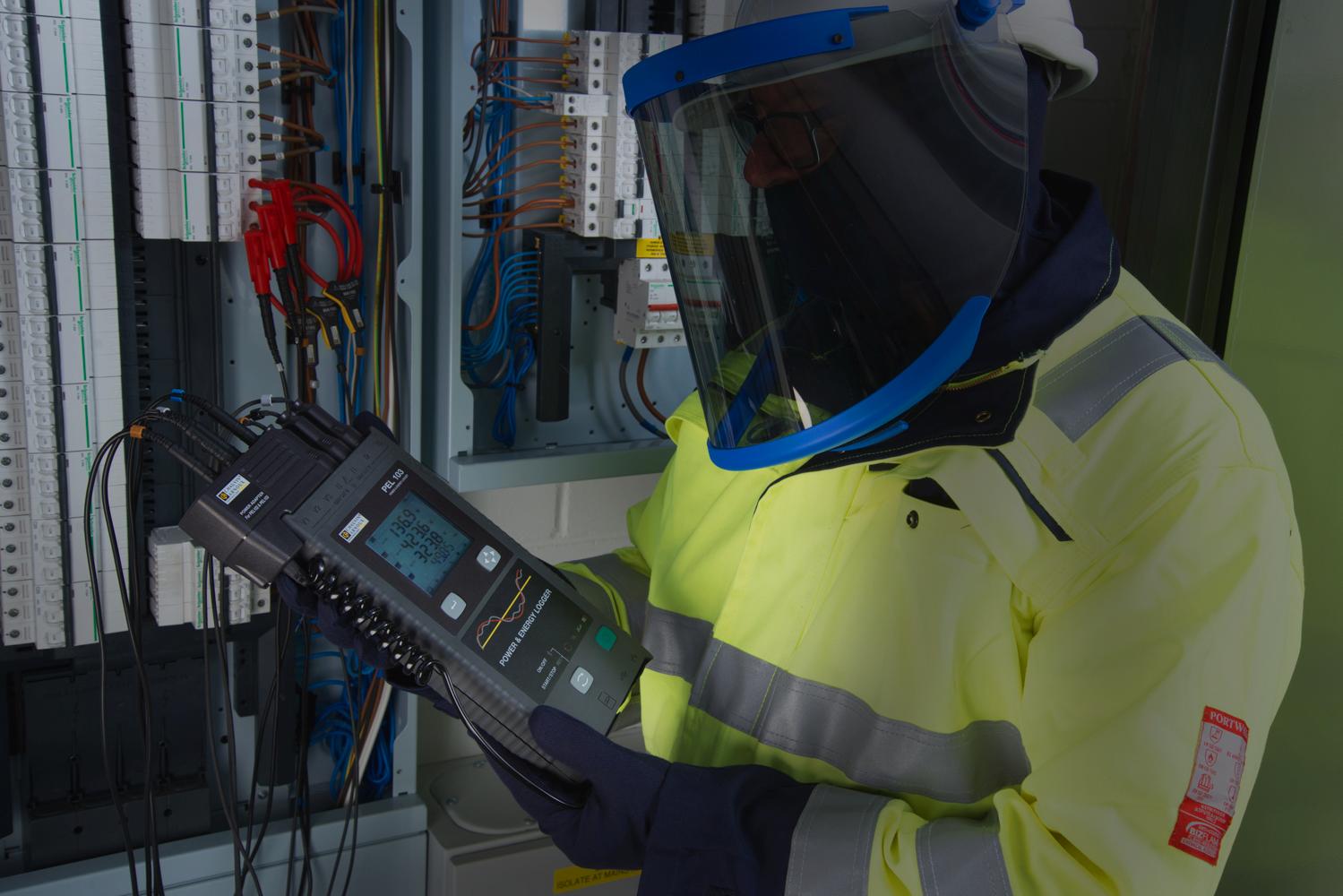
CHAUVIN ARNOUX UK Ltd | 125 YEARS IN BUSINESS | 30 YEARS IN THE UK 1 Flagship Square | Shaw Cross Business Park | Dewsbury WF12 7TH | T: 01924 460494 | E: info@chauvin-arnoux.co.uk
us to learn more
Contact
energy
are
and businesses
to
their energy
iciency. You can reduce
generation,
money and increase productivity. Gain a competitive advantage now with the PEL 103.
The key to a reduced carbon footprint & improved energy e iciency. Our future
needs
changing
need
improve
e
required power
save
MAXIMIZING SAVINGS: POWERING BUSINESSES WITH SOLAR PV ARRAYS AND BATTERY STORAGE

In today’s rapidly changing world, businesses are increasingly seeking sustainable solutions that not only reduce their carbon footprint but also lower operational costs. One such solution that has gained significant popularity is the installation of a commercial solar photovoltaic (PV) rooftop array combined with a battery storage system. This comprehensive system offers a wide range of benefits for businesses, including substantial cost savings, enhanced energy independence, environmental advantages, scalability, flexibility, and optimised energy consumption.
By incorporating a commercial solar PV rooftop array businesses can generate their own electricity and significantly reducing their dependence on the grid while lowering energy costs. Solar power enables businesses to harness clean and renewable energy from sunlight, thereby reducing or even eliminating electricity bills. The initial investment required for installing the system can often be recouped within a few years through these cost savings, leading to increased profitability and improved financial stability.
Integrating a battery storage system with the commercial solar PV array offers businesses greater energy independence and enhanced reliability. Excess solar energy generated during the day can be stored in batteries for use during periods of low solar generation or at night. This stored energy ensures a continuous power supply, reducing reliance on the grid and protecting against power outages. By having a reliable and self-sustaining energy source, businesses can maintain critical operations, improving overall productivity and customer satisfaction.
Apart from reduced energy bills and reliance on the grid, one other
significant advantage of commercial solar PV rooftop arrays is their positive environmental impact. Solar energy is a clean and renewable energy source that produces no greenhouse gas emissions during operation. By transitioning to solar power, businesses can contribute to the global effort to combat climate change, reduce air pollution, and conserve natural resources. Embracing sustainable practices and reducing their carbon footprint enhances the company’s environmental reputation, attracting eco-conscious customers and stakeholders who value businesses that prioritise environmental responsibility.
Commercial solar PV rooftop arrays offer businesses scalability and flexibility to adapt to changing energy needs. With available roof space, companies can easily expand their solar capacity by adding more panels.

This allows them to generate additional electricity to meet growing demands. The modular nature of solar systems enables businesses to incrementally increase their capacity over time, aligning with their future growth plans and energy requirements. The flexibility provided by commercial solar PV systems ensures long-term suitability and the ability to scale up as needed.
HAVING DECIDED TO LOOK AT SOLAR PV WHERE DOES A BUSINESS START?
Before embarking on a solar PV project, businesses must first gain

16 MONITORING & METERING ENERGY MANAGER MAGAZINE • JULY/AUGUST 2023
a comprehensive understanding of their electricity usage patterns by measuring consumption throughout the day and night, assessing variations on a daily, weekly, and monthly

basis, and identifying seasonal fluctuations due to factors such as lighting, heating and air-conditioning.
This is best achieved using a portable power and energy logger like the PEL104 from Chauvin Arnoux, a powerful tool that measures and records key parameters such as voltage, current, power, and energy usage. This data provides valuable insights into the actual energy consumption patterns, identifying peak demand periods and usage trends, as well as inefficiencies and

opportunities to optimise the energy consumption.
The energy consumption data collected by the PEL104 also plays a crucial role in specifying the sizing of a commercial solar PV array. It enables businesses to estimate the required capacity of the solar panels to generate sufficient electricity to meet their energy demands. By considering factors such as the available roof space and orientation, solar irradiation levels, and energy usage patterns, the PEL104 data ensures that the solar PV system is appropriately sized for maximum energy generation and cost savings.
Incorporating a battery storage system into a commercial solar PV array further enhances energy independence and reliability. In this scenario, the PEL104 can help determine the required capacity of the battery storage system by logging energy usage data during non-sunlight hours. This data provides insights into the amount of stored energy needed to meet the premises’ energy demands during periods of low solar generation or high consumption.

To conclude, investing in a commercial solar PV rooftop array and battery storage system offers businesses a wide array of benefits. The significant cost savings achieved through reduced electricity bills, enhanced energy independence, and reliability, make solar power an attractive solution.
Moreover, embracing solar energy contributes to environmental sustainability by reducing carbon footprints and supporting the use of clean, renewable energy sources.

Businesses not only improve their financial bottom line but also position themselves as leaders in sustainable practices, attracting environmentally conscious customers and stakeholders who value businesses committed to a greener future. What are you waiting for?
www.chauvin-arnoux.co.uk
17 ENERGY MANAGER MAGAZINE • JULY/AUGUST 2023 MONITORING & METERING
KNOWING YOUR USAGE –WHY BUSINESS OWNERS SHOULD TAKE CONTROL OF THEIR ENERGY DATA
While wholesale energy prices have fallen from their summer 2022 peaks, there is a substantial lag before these are fed back through to consumers and understandably, it can be a point of frustration for business owners. Regardless of whether prices are now starting to fall, for many businesses they have already felt the impact of the initial hike on their finances. Indeed, electricity prices in the UK rose by 66.7 percent and gas prices by 129.4 percent in the 12 months to March 2023,1 meaning that businesses have already had to accommodate rising costs into their operations, which in turn affects their future plans.
It is something that sustainable technology expert, Pilot Group, is looking to support them in tackling through the provision of its energy management system (EMS). While businesses may want to reduce their energy bills, knowing where to begin can be a daunting task. Many business owners know the cost of their energy consumption but remain stumped as to how to reduce it or hold the notion that measures to combat it will come at an unaffordable cost. Meanwhile a lack of understanding for how their business consumes energy adds further complexity for owners.
Businesses tend to consume energy in multiple forms, from electricity to natural gas, to oil. As a result, tracking and monitoring energy usage can be a complicated task. Another factor is the misconception that energy is a fixed cost and is a necessary expense that cannot be reduced, and so many owners do not prioritise energy management or seek out opportunities for energy savings. As a result, they carry on enduring higher bills for far longer than is necessary.
1 https://www.ons.gov.uk/economy/ inflationandpriceindices/articles/ costoflivinginsights/energy

For organisations looking to rise to the challenge of energy bills, they should look at implementing measures which will allow them to take control of their data. By implementing an analytical approach as a starting point for reducing their energy consumption, businesses can assess in fine detail their energy outputs and identify where realistic savings can be made. In doing so they can empower themselves to make strategic decisions which will benefit the company’s energy outputs going forward. This is where tools, such as Pilot Group’s EMS, can play a crucial role.
Pilot Group’s easy-to-use EMS system enables organisations to streamline their operations with the use of smart sensors and a self-learning algorithm which increases heating efficiency. This, combined with a user-friendly portal, which can be accessed remotely, allows users to monitor multiple sites. Averaging a 40 percent reduction in consumption from gas and heating, the system can bring about huge savings. Meanwhile, it gives them an overview of their energy consumption which can improve their business’ facility performance.

As well as the financial benefits, the system allows business owners to plan ahead for expected energy costs. This is particularly important for businesses working in industries with high energy consumption, such as manufacturing, agriculture, and transportation. By providing an overview of all aspects of energy usage, from heating to lighting, to air conditioning, it brings forward valuable insights into energy consumption which allows for energy savings and efficiency improvements.
Effective energy management and monitoring can be a vital tool in helping businesses meet energy bills head on. It can open the door to a wealth of data which was previously unavailable, and crucially, it enables a business owner to see exactly where their company is using energy and the inefficiencies across its operations which should be addressed. As a result, users of energy management tools can see almost immediate reduction in gas and electricity costs with an optimised system in place.
A key ambition of Pilot Group is to empower the UK’s businesses to take control of their data, and therefore their energy bills. Pilot Group has been assisting companies across the country to make significant savings through the use of its EMS system. By allowing companies to take an analytical approach, the EMS enables them to track their energy usage across all areas of the business, and crucially, assess where savings can be made with actionable solutions.
For businesses who want to take control of their data, Pilot Group, is on hand to help with a proactive approach which will help them tackle the pressure of energy tariffs. For organisations interested in reducing their energy and carbon footprint, it would be worth giving us a call.
For more information visit https://www.thepilotgroup.co.uk/ Lee Morgan is Managing Director of Pilot Group Ltd’s Energy Management Division, who support organisations meet carbon reduction targets using technologies and lead the way in smart, safe, and sustainable infrastructure solutions.

18 MONITORING & METERING ENERGY MANAGER MAGAZINE • JULY/AUGUST 2023
Lee Morgan, EMS Managing Director, Pilot Group
MULTIPLE TINYTAG ENERGY LOGGERS ARE USED BY CENTRAL ELECTRICALS
Central Electricals International Limited (CEIL) is a 70-yearold electrical engineering and contracting company based in Kenya. Qualified and certified, CEIL has a regional footprint with operations across six countries in East and Central Africa. David Lumatete, General Manager – Solar Division at Central Electricals, uses Tinytag Energy Loggers to monitor the periodic energy consumption of prospective clients.
Tinytag Energy Loggers are used to establish the daily load profiles of Central Electricals’ clients, showing the variation in electrical load versus time. This daily profile is an important part of solar photovoltaic (PV) system designs as it validates whether the proposed system will satisfactorily meet the client’s power needs.
The Tinytag Energy Logger monitors voltage (V) and current (AC) and power (kW) and determines power factor and energy usage (kWh) data. Discussing why he chose the non-invasive Tinytag Energy Logger for monitoring client load profiles, David says, “Tinytag Energy Loggers are

small, portable, and fairly easy to install on-site. Also, the recorded data can be simply downloaded and exported to third-party software for analysis.”
The data recorded by the Energy Logger is used to identify the peak power demands of the client and is then exported to Microsoft Excel to determine daily energy consumption. Data is also transferred to PVsyst, a specialist software for architects, engineers, and researchers.

Importing the data to PVsyst allows David to determine the renewable fraction (the fraction of the energy delivered to the load that originated from renewable power sources) for reference during the design of commercial and industrial solar PV systems.

Central Electricals recently purchased additional Tinytag Energy units to expand their power monitoring capabilities and maintain accurate data collection to inform solar power solutions.
https://www.geminidataloggers.com/

19 ENERGY MANAGER MAGAZINE • JULY/AUGUST 2023 MONITORING & METERING
THE ONLY PUBLIC SECTOR ENERGY JOURNAL Register now to receive your digital issue of Energy Manager Magazine FREE of charge Image © East Street Imagery energymanagermagazine.co.uk/ subscribe
DO YOU KNOW HOW MUCH ENERGY YOU WASTE?
Kevin Jackson –Strategic Solutions Director - eEnergy

It is true that every organisation wastes energy. It is also true that few organisations measure how much energy they waste. The amount of energy wasted by organisations can be around 30%, but the figures will vary for each and every site. Despite organisations having to keep detailed records of energy consumption and more recently the carbon dioxide (CO2) emissions resulting from the consumption, there is no requirement to report on energy waste.
SO COULD YOUR ENERGY WASTE BE 30% OF YOUR CONSUMPTION?
Well, yes it could!
If you consider a day / night tariff, the lower charging rate for night units is often charged between midnight and 7am (there are slight regional and tariff variations.) with the remaining 17 hours of day rate. If an appliance was left on for a full 24 hours rather than the 17 hours of day time use required, then the wasted energy would be nearly 30%.
7 hours of wasted energy / 24 hours = 29.2% energy waste
So if your consumption at night is more than 20% of your total daily consumption, it could be that you are leaving things on overnight, unknowingly. However, this is not the only area where energy is wasted and not all energy is wasted at night or out of hours
How many times have you seen lights switched on when not needed
or not switched off when finished with? How many times is equipment switched on ‘just in case’ it is going to be required? There are many other examples. Put simply, energy waste is consuming energy at any time in any form when it can be avoided.
SO HOW DO WE START TO UNDERSTAND HOW MUCH ENERGY WE WASTE?
One of the easiest and simplest ways to start identifying how much energy you waste is to look at the insight provided by your half-hourly electricity data. One year’s half-hourly data will provide 17,520 meter readings i.e one read for every half an hour of every day, even Christmas Day. You can then compare periods with each other.

• Last year’s consumption with this year’s consumption
• Last winter vs this winter or last summer vs this summer
• Last month’s vs this month or last
December vs this December
• Last week with this week or even each day against each other.
Note: normalising for working hours, activity and weather may be required
When profiling energy we often look at periods of consumption within a day to identify energy waste. Terms such as baseload, maximum demand and shoulders are used to segment the consumption for comparison.

• Baseload – the 24/7 energy that is used all day every day
• Highest demand – the maximum amount of energy used in a period
• Open shoulder – the period from initial operation to daily BAU
• Closed shoulder – the period from starting to close down to baseload consumption (often at the end of a BAU day)
Comparing baseload, demand and shoulders for different periods is a great way to start estimating how much energy you waste. i.e. If you could achieve the lowest baseload for
20 ENERGY MANAGEMENT ENERGY MANAGER MAGAZINE • JULY/AUGUST 2023
a single day for all the other days of the year, how much would this save you?
Once you have determined how much energy you waste, then you can determine what actions you need to take and how much you are prepared to invest to eliminate it.
Eliminating energy waste is often approached by addressing one of three measures.
• People – everyone is an energy manager and with awareness they can stop energy waste

• Controls – energy controls such as set points and time clocks need to be managed
• Equipment – equipment with higher energy efficiency ratings will reduce waste
These measures are then prioritised by using a simple cost-reward matrix grouping the savings into no cost, low cost and capital cost investment.
• No cost – these are often people or control related achievable as part of BAU
• Low cost – these are activities that be achieved from within year budgets
• Capital cost – projects that will require funding from a CAPEX budget
SO WHAT HAVE WE LEARNT FROM THE ABOVE?
• Everyone wastes energy and 30% energy wastage is definitely possible Identifying energy waste is simple and can be done using existing half-hourly data Waste elimination often addresses three measures, people, control and equipment
• Waste elimination activity can be prioritised into no-cost, low cost and capital cost.
SO WHAT NEXT?
eEnergy believe that reaching Net Zero should be both possible and profitable for all organisations. Eliminating energy waste is a great way to kick-start your Net Zero journey. Our MY ZeERO intelligent monitoring platform measures and reports on energy, cost and carbon at circuit level in real time to help identify energy waste. So, if you’re ready to start measuring your energy waste and identifying savings, we are ready to help you take the next step.
To learn more about how eEnergy can help you eliminate energy waste, reduce your costs and carbon emissions visit www.eenergy.com
VITAL ENERGI CREATE SUSTAINABLE FUTURE FOR BRIDLINGTON HOSPITAL
Vital Energi are working with York and Scarborough Teaching Hospitals NHS Foundation Trust on a multi technology energy project which will see Bridlington Hospital on course to become one of the most sustainable NHS sites in the UK.

Vital Energi have installed air source heat pumps and solar PV systems to significantly reduce Bridlington Hospital’s carbon emissions. The energy efficiency of the hospital will be improved through the installation of energy conservation measures, including thermal insulation, and modifying air handling units to reduce energy consumption. The energy project also includes the optimisation of the heating and hot water systems across the hospital estate which will both reduce energy usage and improve the performance of the new heat pumps.
Currently, the hospital’s heating and hot water is generated by 20-year-old gas fired boilers and a gas fired CHP system. The project will see the CHP being de-commissioned and one of the boilers removed to make way for the installation of a 600kW air source heat pump system which will be capable of supplying 100% of the heating and hot water demand of the hospital. When coupled with the new 750kWp solar PV system, the heat pumps will provide zero carbon heat generation at the hospital.
The solar PV system, which combines over 1,600 panels both ground and roof mounted, will be capable of supplying 100% of the electricity demand of the
heat pumps, meaning at times 100% of the heat demand of the hospital will be met via a 100% renewable source. The solar PV will also provide a proportion of the hospital’s electricity requirements too. The hospital’s energy related carbon emissions will be reduced by over 50% compared to current operations, and as the national grid continues to decarbonise electricity generation, these savings will increase further.
The project received £4.7m grant funding from the Public Sector Decarbonisation Scheme (PSDS), which is administered by Salix Finance on behalf of the Government’s Department for Energy Security and Net Zero (DESNZ), formally part of the Department for Business, Energy and Industrial Strategy, to replace old gas (oil and coal) powered heating and hot water systems with low carbon systems whilst reducing the heat requirement through energy efficiency measures such as increased insulation. The funding was secured through the combined efforts of the Trust and Vital Energi teams working together to submit a complex application within an extremely challenging timeframe.
DESNZ, York and Scarborough Teaching Hospitals NHS Trust, and Vital Energi are delivering the project through the Carbon and Energy Fund Framework, which has been specifically created to fund complex energy infrastructure upgrades for public sector organisations. www.vitalenergi.co.uk
21 ENERGY MANAGER MAGAZINE • JULY/AUGUST 2023 ENERGY MANAGEMENT
Drone image of the Bridlington Hospital site
WHAT WILL ENERGY MANAGEMENT LOOK LIKE IN 2030?
The way we’re using electricity is changing. Decarbonisation of heat and power and an increase in electricity consumption means greater dependence on intermittent renewable energy sources like wind and solar.
These changes mean we need to work differently to balance electricity supply with demand. As a result, we’re shifting from a centralised energy system to a decentralised or distributed energy system – where energy is generated by lots of different operations all around the country, away from the main grid.
We all have a role to play in this change process. The way your organisation manages its electricity today might look very different in 10 years’ time.
WHY SHOULD I CHANGE THE WAY I USE AND MANAGE ENERGY?
Shifting how we use our energy will result in a host of benefits for your business and the UK:
• Support system stability: by reducing your consumption at times of high demand, you’ll be helping to keep the UK electricity demand in line with supply, preventing blackouts.
• Cost avoidance and revenue generation: having selfgeneration or battery storage means you can rely on your own resources when costs peak. Plus, when it’s in demand, you can deliver power back to the grid, which can make you money.
• Reach net zero targets: by reducing your consumption or getting your own renewable

generators, you’ll reduce the need to call on fossil fuel power generation at peak times, and ease peaks and troughs in energy demand.
• Future proof your business: build resilience by not having full reliance on the grid for your power.
THE ENERGY MANAGEMENT SYSTEM OF THE FUTURE
Energy management is changing. Knowing what we know now, and the future demands on the energy system, this is what your business energy use could look like in less than a decade.

IT STARTS WITH THE SUPPLY
Let’s start at the beginning: energy supply. Hopefully you’re already supplied with 100% renewable electricity, but with the average fuel mix across all UK suppliers sitting at just 38%, it’s worth checking. At Drax, our product offering has been approved by EcoAct, an international consultancy that independently reviews our product offering, verifying our renewable electricity supply.
Your 100% renewable electricity doesn’t necessarily have to come from a generic unknown source. A Corporate Power Purchase Agreement (CPPA) is a way to connect the power your organisation consumes to a specific renewable power generator. Not only do CPPAs help you manage power price risk over longer terms, but they can improve your environmental credentials, building brand value too.
We’ll be well beyond the smart meter deadline come 2030, and all eligible organisations should have had them installed. In fact, smart meters will enable a smarter, decentralised energy grid. The more detailed usage data they provide helps the grid to predict peaks and troughs in demand, and therefore match available supply more effectively to demand.
SELF-GENERATION
Another important element of future energy management is selfgeneration. Not only does renewable generation provide clean energy for your organisation, but with a Power Purchase Agreement (PPA), it provides an extra source of income by selling any excess power back to the grid. At Drax, we’ve partnered with over 2,100 renewable energy generators, buying
22 ENERGY MANAGEMENT ENERGY MANAGER MAGAZINE • JULY/AUGUST 2023
1.3 TWh of their excess electricity and in turn supplying it to UK businesses. OPTIMISATION AND ELECTRIFICATION
Onsite battery storage is an increasingly viable method of storing energy at scale, and advances in technology are making them more economical for businesses. With battery storage you’ll be able to store excess renewable energy you’ve generated. You can then discharge this electricity when needed, without having to call on the grid or fossil fuel sources.
As well as batteries, it’s likely you have other electric assets – machinery or energy intensive operations like refrigerators, engines or lighting - that could be optimised. With energy optimisation and flexibility, you’ll be able to lower your energy consumption at peak (more expensive) times. This might involve shifting some processes to run at night when energy is cheaper, shifting a tea break or turning off machines for an hour.
2030 will be a big year for vehicles, when the ban on selling/ purchasing new internal combustion engine (ICE) vehicles will be active. If your organisation operates a fleet of vehicles, some, if not all, should have made the switch to electric vehicles (EVs). With an electrified fleet, you’ll be benefitting from zero tailpipe emissions as well as lower TCOs (total cost of ownership).


Whether you own a fleet or not, by 2030 we can expect charging stations to be commonplace in all car parks. It’s worthwhile planning ahead and installing charging infrastructure on site for colleagues, customers and fleet vehicles. If you choose all of these measures, you’ll be able to use renewable, selfgenerated electricity – stored in your batteries – to charge when prices peak. And, with vehicle to grid (V2G) technology developing all the time, it’s likely you’ll be able to use vehicles as an electric asset by 2030, too.
BEHIND YOUR ENERGY MANAGEMENT: YOUR CARBON FOOTPRINT

Behind your physical energy management system, carbon reporting will be playing an important role in meeting environmental targets. With 100% renewable energy supply and renewable energy certificates (RECs) you’ll be able to report your Scope 2 carbon emissions as zero. And with fleet electrification and energy optimisation, you’ll have cut your Scope 1 emissions, too.
Right now, in 2023, carbon offsetting certificates will help you to offset the harder to abate emissions, most typically found in Scope 3. But by 2030, carbon removal schemes will be operational. BECCS – bioenergy with carbon capture use and storage – will allow Drax to achieve its ambition to be a negative carbon company by 2030, and help other businesses with their ambitions, too. www.drax.com
23 ENERGY MANAGER MAGAZINE • JULY/AUGUST 2023
ENERGY MANAGEMENT
A
www.pssa.info Join us today
wide group of people working across all areas of the Public Sector – to educate, train, support and connect as we work towards a more sustainable future.
ACCUMULATING SMALL SAVINGS IS HAVING A LARGE TOTAL EFFECT ON CARBON REDUCTION
Armin Anders, Co-founder &

VP Business Development, EnOcean


The importance of reducing greenhouse gas emissions – typically carbon-containing gases, most notably CO2 – to prevent excessive global temperature rise is well understood. Our major energy sources, for generations now, have been fossil-based and therefore laden with carbon-based compounds that combine with oxygen when burned to create those dangerous greenhouse gases. They also emit other toxins as well as particulates that are damaging to health.
For some time now, we have been pursuing the goal to transition our energy sources from these traditional fuels to renewable sources. Springing to mind are perhaps the prominent of these, wind and solar energy with 3.37 terawatts of installed capacity now in operation worldwide, according to Statista1. Other sources include geothermal energy harboured within the earth’s core and wave energy induced by the gravitational effect of the moon.
Taking advantage of these sources is all about energy harvesting: converting that ambient energy into a form that is usable for human purposes. This is usually electricity and is predominantly produced by the large renewable-energy farms, both wind and solar, being installed in large numbers and across large areas of the earth’s surface.
These energy sources are quite satisfactory in many ways: today’s power electronics and conversion technologies can turn those few electron volts from PV panels, or the irregular, harmonicladen waveforms from a wind turbine into usable electrical power. This may be a DC supply at a suitable voltage for
1 Global renewable power capacity 2022 | Statista
powering loads directly, or for charging battery storage. Or it may be a highquality AC output at a suitable voltage and frequency to feed in to the grid.
MAKING LESS GO FURTHER
One aspect that is less favourable, however, is scarcity. While there may be an abundance of sun and wind, and perpetuity is not in doubt, the quantity of electrical energy produced is quite low in relation to global demand, and generation is only possible when enough sun or wind is present. These times are not predictable or regular. There are several practicable responses to this problem. One is storage: to make as much electricity as possible while the sun shines (or the wind blows) and store this in a battery array to be used later when ambient energy sources are not present. This
is as valid in small domestic microgenerator applications as in utility-scale applications that integrate large gridconnected battery arrays. Some suggest these could be built from electric-vehicle batteries that still have about 80% of their capacity but are deemed to be unsatisfactory to continue their life on the road. Grid-connected storage is a hot topic with great potential, although best practices are yet to be finalized and much work remains to be done to install and connect enough storage.
The other side of the coin lies in reducing overall energy demand to meet the increasing installed capacity for renewables. There are several ways to do this, including developing more efficient appliances, improving powerconversion efficiency, and adopting more efficient processing techniques such as moving AI inference to edge devices and IoT sensors. We could also consider authoritarian measures such
24 ENERGY MANAGEMENT ENERGY MANAGER MAGAZINE • JULY/AUGUST 2023
as enforcing limits on personal EVmileage quotas through measures such as battery-charging caps or geofencing.
SMART BUILDINGS


It is well known that a large proportion of the world’s energy is consumed in buildings, to power lighting systems, room heating, and water heating. Historically, these have been powered through a combination of electricity, as well as directly burning natural gas and mineral oil. In the push for net zero, energy for heating is expected to transition away from gas and oil towards electricity. This will have the effect of increasing the electricity demand imposed by buildings.
Reducing the energy needed to operate buildings, for the health and comfort of occupants, is one of many imperatives in the world’s pursuit of sustainability. Low-energy LED lighting reduces power demand by about an order of magnitude compared to traditional incandescent lamps. In the EU, legislation against inefficient lighting technologies included a ban on high-wattage incandescent lamps in 2009, followed by subsequent bans on lower wattages, that have encouraged widespread adoption of LED lamps in residential and commercial/industrial applications.
Also ongoing is the move towards smarter buildings that are capable of autonomously managing heating and lighting for optimum comfort and energy efficiency. A great deal of progress can still be made here, although the presence of large quantities of legacy
electrical infrastructure including wiring and control systems such as thermostats tends to slow the pace.
Wireless technologies can offer a solution, allowing new controls to be installed with no new wires or significant decommissioning of old wiring. Bringing wireless technology together with energy harvesting to create self-powered controllers for lighting and HVAC (heating, ventilation and air conditioning) systems is facilitating the introduction of autonomous controls in smart buildings. No new wires are needed to provide power for the internal circuitry of the smart controllers, or to connect the controllers to smart lights or HVAC systems. And introducing these controllers has zero impact on the building’s overall energy demand since they are self-powered by ambient energy, using Peltier-type thermoelectric sources, solar cells, or kinetic energy conversion.
EnOcean has led the development of energy-harvesting smart controllers and now has a large installed base throughout commercial, industrial and residential buildings in Europe and worldwide. Individually, each of these units saves microwatts by powering internal circuitry from harvested energy. The energy saved by enabling smarter, autonomous control that eliminates reliance on occupants turning off lights when not needed, or turning heating settings down to reasonable levels is more significant. Autonomous lighting control, managed according to ambient light levels sensed using photoelectric detectors, permits additional valuable savings by adjusting the electrical
lighting power to work with the ambient daylight, thus ensuring lighting is continually optimised throughout the day. Smart controls are reckoned to save about 20% of HVAC energy and 8% of electricity consumed by buildings.
CO2 IMPACT OF ENOCEAN
Now having a large installed base of EnOcean technology, the CO2 impact can be assessed, and it is significant. EnOcean has developed a calculator, leveraging commonly used references, to quantify the savings in energy and, from this, the savings in generated CO2 achieved through EnOcean units controlling HVAC and small electrical power in buildings. More than 1 million buildings are now installed worldwide with EnOcean technology, in smart homes and commercial buildings. Overall, EnOcean is managing about 221 million square metres of smartbuilding floorspace. Based on official references for the energy demands of HVAC and small electrical power systems, these devices are currently saving 15% energy on average and by that more than 1.4 million tons of CO2 from the atmosphere, every year! And as more sensors are continuously installed, the annual savings will continue to increase. Alone, of course, this is not enough to fulfil our urgent need to limit emissions and prevent damaging global temperature rise. But Smart Heating and Smart Power Control are comparatively inexpensive measures with a significant contribution that should encourage us all to increase our efforts to keep making progress. www.enocean.com

25 ENERGY MANAGER MAGAZINE • JULY/AUGUST 2023
ENERGY MANAGEMENT
THE ONLY PUBLIC SECTOR ENERGY JOURNAL Register now to continue receiving your digital issue of Energy Manager Magazine FREE of charge energymanagermagazine.co.uk/ subscribe www.energymanagermagazine.co.uk
ARE SUMMER CLIMATE PRACTICALITIES IMPACTING ON UK DECARBONISATION EFFORTS?
In their latest Progress Report1, published at the end of June, the Climate Change Committee highlighted the growing issue of heatwaves, “For many in the UK, 2022 was the year that climate change arrived, with the UK’s first ever 40°C day. It was the UK’s warmest recorded year and one of the six warmest years on record globally. The record-breaking temperatures seen in the UK in summer 2022 brought unprecedented numbers of heat-related deaths, wildfire incidents and significant infrastructure disruption.”
When UK temperatures exceeded 30°C for the first time this year – in the same month the CCC Report came out – the National Grid ended the country’s longest run of energy supply 1 https://www.theccc.org.uk/publication/2023progress-report-to-parliament/
without coal-fired generation, requesting that Ratcliffe-on-Soar power station be brought on line to ensure secure supply. There were several factors behind the decision to fire-up the power plant: low wind generation, planned maintenance at Torness nuclear power station which cut available generation by 1.3GW, together with a fault on the 1.4GW North Sea Link interconnector where repairs reduced power flow by half.
But an additional strain – relatively new for the UK – has come from the increasing demand for air conditioning. As climate change continues to impact weather conditions, the UK will experience more extreme heat, with the duration of heatwaves more than doubling from a historical average of five days to a current average of 13 days. All of this drives the growth in air conditioning, and government research2 indicates that the likelihood of demand for cooling will increase overall UK power consumption by 15%. The IEA point to a cycle where emissions increase temperature, leading to greater demand for air conditioning, whereby more carbon emissions are generated, and Fatih Birol, IEA Executive Director states, “Growing demand for air conditioners is one of the most critical blind spots in today’s
2 https://assets.publishing.service. gov.uk/government/uploads/ system/uploads/attachment_data/ file/1019896/cooling-in-uk.pdf

energy debate.”3 This clearly impacts on UK Net Zero ambitions, exacerbated by drops in wind-generated power when high pressure weather systems create the heatwaves that lead to this increased demand for air conditioning.


For this June, bringing Ratcliffe-onSoar power station online maintained UK energy security. One of several plants to have its lifespan extended after Russia’s invasion of Ukraine to help avoid winter blackouts, this and other coal-fired plants are scheduled for shutdown by September next year. As part of the country’s Net Zero ambition, these shutdowns should be welcomed. But, as British summers get hotter, the impact of climate change is leading companies to manage their own strategies for power resilience and carbon emission reduction. In April, a study canvassing more than 1,500 UK businesses found that almost 75% are concerned about climate impact for the next decade4, with more than half already reporting disruption to business due to extreme weather events such as flooding, storms, and heatwaves. A third of UK companies have invested in mitigating climate change impacts – 30% spending at least £100,000 and 10% spending
3 https://iea.blob.core.windows.net/ assets/0bb45525-277f-4c9c-8d0c9c0cb5e7d525/The_Future_of_Cooling.pdf
4 https://www.ajg.com/uk/news-andinsights/2023/april/half-of-uk-businessesalready-impacted-by-climate-change/
26 ENERGY STORAGE ENERGY MANAGER MAGAZINE • JULY/AUGUST 2023
We all understand the threats to power supply during the colder months, but pressures on energy infrastructure in summer represent a new concern for UK businesses.
Richard Kerr, Head of Marketing at Powerstar, considers the issues facing British companies as summers get hotter, and looks at battery energy storage as a means to maintain power resilience while working towards Net Zero.
over £1 million – with climate protection strategies focused on reducing carbon emissions (44%), setting Net Zero targets (32%), and investing in environmentally friendly technology (32%).
Where companies are looking to reduce carbon emissions and maintain power resilience, battery energy storage systems (BESS) are proven technology, supporting Net Zero strategies across diverse sectors including food and drink processing; health services; high-value and high-volume manufacturing; data centres; retail, and leisure. And, where the Grid is now under greater pressure in summer, the power resilience that BESS offers is helping businesses to mitigate climate-related issues during hot weather, reducing carbon emissions while providing business-critical resilient power.
Given that energy security is a pressing issue, many companies already rely on uninterruptible power supply (UPS) technology, to protect vital equipment in the event of disruption to Grid supply. However, traditional UPS will largely sit idle while consuming energy, switching from AC to DC and losing up to 15% capacity. For a typical 1MW system, this means around £200,000 unnecessary annual energy spend and significant carbon emissions. A modern BESS can offer site-wide energy protection, providing emergency power in the event of disruption either until

Grid power resumes or until back-up generation is brought onstream, while losing only one percent capacity.
Some businesses already factor renewables into their own site’s energy mix, largely through solar PV, and the harnessing of solar-generated power may be a micro-level response to heatwaves across the UK. While solar energy can only cover a small percentage of the country’s energy demand, the capacity to store on-site generated solar power to a BESS for use when needed means that companies can maximise solar assets, storing energy as generated to be used either at peak times or when there is any disruption to Grid supply. Taken in isolation, solar arrays are not a particularly efficient solution for on-site power generation but, when deployed in tandem with BESS – which stores the energy generated during sunny conditions for use when most commercially and operationally beneficial – investment in solar and BESS can help companies maintain power resilience while also working towards Net Zero targets.
For one client, an organisation that was looking to protect critical data from Grid disruption while also managing their existing 100kW solar array, Powerstar’s 250kW BESS installation has provided energy security – including site-wide backup for 2 ½ hours at peak load – while
managing the power from their solar infrastructure to maximise the generation from their renewable investment. For another client, in the healthcare sector where UPS is absolutely critical and the demand to decarbonise has strict and pressing targets, Powerstar’s BESS installation was called upon twice in one day, with the new system supporting the full load in each instance. This new BESS installation has eliminated nearly 200 tonnes of CO2e annually for the Hospital Trust, while saving about £225,000 in energy costs when compared with the cost of running traditional UPS systems.
Ultimately, the pressure of climate change and hotter summer months will increase demands on the Grid, potentially hampering nationwide Net Zero strategies whenever coal-fired power plants are brought back into play. That said, companies can take control of their own sustainability plans and ensure their own power security, utilising modern energy efficient technologies.
For more information about the critical aspects of the Energy Trilemma: affordable, secure, and sustainable power, read Powerstar’s whitepaper here: https://offers.powerstar.com/energytrilemma-white-paper
Or contact us: www.powerstar.com

E: info@powerstar.com
T: 0333 230 1327
27 ENERGY MANAGER MAGAZINE • JULY/AUGUST 2023 ENERGY STORAGE
USING BATTERY ENERGY STORAGE TO POWER THE EV TRANSITION
North Tyneside Council is revitalising its Killingworth Site depot, in a multi-millionpound project supported by the European Regional Development Fund (ERDF). A core aim of this initiative is to futureproof the site for sustainability and energy efficiency. The depot – which is home to around 1,000 council staff and partners - now includes a solar PV array and car ports delivering 700 kilowatts at peak generating around 600,00kW/h of electricity per annum. There are also more than 40 electric vehicle (EV) chargers being installed in the coming months, which will increase as the authority transitions a significant part of its fleet to EV over the next few years.
The Council realised it would be giving 20% of the solar energy it generated back to the grid, as it had no way of storing the excess energy created during daylight hours – and this electricity could be used to charge its electric vans at night. The authority turned to Connected Energy in nearby Newcastle for a solution.

Connected Energy has developed a unique battery energy storage system (BESS), which is already used to support solar storage and EV charging across the UK and Europe. Its pioneering E-STOR system uses batteries from end-of-life electric vans, giving them a second life in BESS. Typically, the batteries still have up to 80% of their original energy storage capacity at the end of the vehicle’s life, making them ideal for this application.
Furthermore, Connected Energy’s intelligent management system enables E-STOR to integrate with solar PV, the grid, and other smart technology like building management systems. This means E-STOR can balance a site’s energy needs, reduce energy bills, and make the most of on-site renewables.
Ian Lillie, strategic facilities manager for North Tyneside Council, with responsibility for the depot, said: “Since installing and commissioning the PV array in February 2023 we have already generated over 100,000kW of green energy. However, we’ve had to give back over 20,000kW to the grid because we can’t store it.
“By using Connected Energy’s battery energy storage system, we can capture that energy and use it to charge our electric vans and indeed the buildings on site overnight. And in the winter, we can use E-STOR to store energy from the grid on lower tariffs at night, to use during the day. The combination of solar
and BESS should significantly reduce our electricity bills while also cutting carbon emissions from our energy consumption.”
TAKING ENERGY EFFICIENCY MEASURES TO NEW LEVELS
The council has added a raft of energy efficiency measures to the refurbished buildings on the Killingworth Site, including a heat recovery system, more efficient boilers, LED lighting and a building energy management system. “We have smart sub-metering capabilities to support energy efficiency, but battery energy storage takes this to another level,” he added. “It effectively acts as the brain of our smart microgrid, communicating with and controlling all the other elements. This helps us to deliver the best possible economic and environmental return on investment.
“E-STOR repurposes batteries from end-of-life electric vans, so the ability to power the vans of the future using batteries from the vans of the past was a compelling argument for us. On top of that, the scalability of the E-STOR solution means we can ramp up our use of BESS on site as the Council expands its own EV fleet.
“This site was developed as a research centre of excellence in the mid ’60s following
the discovery of North Sea gas, playing its part in powering our region’s economy and developing new technologies for the transmission, storage and distribution of gas used both within the UK and across the world. Now it will be an exemplar of the new energy economy, while also showcasing how innovative technology can combine to deliver both efficiency and sustainability. We’re delighted that pioneering battery energy storage systems developed right here in the North-East will play an integral part in this.”
Connected Energy has been developing and delivering battery energy storage projects for over ten years.

Matthew Lumsden, CEO and founder of Connected Energy said: “The concept for our systems came from our work in the North East on a number of electric vehicle trials and driven by the mission to find a second life use for EV batteries.
“We now have over 30 systems operating across the UK and Europehowever this will be our first installation in the North East. We’re proud to see a system in action so close to our HQ and look forward to seeing the benefits it will bring to the location.”
To find out more about Connected Energy’s BESS solutions, visit www.connected-energy.co.uk
28 ENERGY STORAGE ENERGY MANAGER MAGAZINE • JULY/AUGUST 2023
Batteries from yesterday’s electric vans will help power the EVs of tomorrow in a pioneering new project in North East England. Connected Energy’s work with North Tyneside Council is helping the local authority cut its carbon emissions and optimise its solar power generation.
SUSTAINABLE STEAM GENERATION: POWERING A GREENER FUTURE
In the pursuit of a sustainable and eco-friendly future, the importance of transitioning to clean and renewable energy sources cannot be overstated. Among the various methods of energy production, steam generation plays a significant role in many key industries, electricity generation, and district heating systems. By adopting sustainable practices in steam generation, we can reduce greenhouse gas emissions, improve energy efficiency and pave the way for a greener and more sustainable world. In this blog, we will explore the concept of sustainable steam generation, its benefits, and key strategies that can be employed to achieve it.
THE SIGNIFICANCE OF SUSTAINABLE STEAM GENERATION
Steam generation is an integral part of many industries, including food and beverage, healthcare, pharmaceuticals and chemicals. Traditionally, steam generation has relied heavily on fossil fuels, leading to significant carbon emissions and environmental concerns. However, by embracing sustainable practices, we can transform steam generation into a clean and environmentally friendly process.
TRANSITIONING TO RENEWABLE ENERGY SOURCES
One of the primary strategies for achieving sustainable steam generation is shifting from fossil fuels to renewable energy sources. Some viable options include:
a. Biomass: Biomass steam generation utilises organic materials such as wood chips, agricultural and food residues, or dedicated energy crops to produce steam. By burning biomass, carbon emissions are reduced as the process releases only the carbon that the plants absorbed during their growth.
b. Concentrated Solar Power (CSP): CSP harnesses the power of sunlight to generate steam through the use of mirrors or lenses that concentrate solar energy. This method
provides a sustainable and emission-free source of heat for steam generation.
c. Geothermal Energy: Geothermal steam generation utilises the natural heat from the Earth’s core to produce steam. This renewable energy source is abundant and can power steam turbines without relying on fossil fuels.
d. Electric: Decarbonising the power that generates steam is, of course, a critical step. The usual method here is to switch from gas-fired to electricity, whether with a new boiler once the existing equipment reaches end-of-life or by retrofitting the burner. Electricity generation itself is rapidly changing to relying more on renewable sources, but in the near term, using electricity will incur more operational costs than gas. That isn’t stopping organisations from acting now, with the UK’s National Health Service recently negotiating a new energy supply deal to ensure 100% renewable electricity across its building portfolio. By procuring renewable electricity, they can also remove the scope 2 emissions associated with electricity use.
ENERGY EFFICIENCY AND WASTE HEAT RECOVERY
Improving energy efficiency in steam generation systems is essential for sustainability. By implementing energy-saving practices and technologies, we can reduce energy waste and enhance overall system performance. Key strategies include:
a. High-efficiency boilers: Modern, well-maintained boilers with advanced combustion and heat transfer technologies can significantly improve energy efficiency and reduce fuel consumption.
b. Waste Heat Recovery: Capturing and utilising waste heat from steam generation processes can be employed to preheat feedwater, generate additional steam, or provide heat for other industrial
processes, thereby maximising energy utilisation and minimising waste.
COMBINED HEAT AND POWER (CHP) SYSTEMS
CHP systems, also known as cogeneration, are an effective way to achieve more sustainable steam generation. By simultaneously producing electricity and useful heat from a single fuel source, CHP systems can achieve higher overall energy efficiency and reduce greenhouse gas emissions. Steam turbines integrated with CHP systems can generate electricity while harnessing the waste heat, providing a sustainable solution for various industries.
CARBON CAPTURE AND STORAGE (CCS)
In cases where fossil fuels are still used for steam generation, implementing Carbon Capture and Storage (CCS) technology can help reduce or remove carbon emissions. CCS involves capturing CO2 emissions from steam generation processes and storing them underground, preventing them from entering the atmosphere and contributing to climate change.
CONTINUOUS MONITORING AND OPTIMISATION
Regular monitoring, analysis, and optimisation of steam generation processes are crucial for maintaining efficiency and identifying areas for improvement. Advanced monitoring systems and predictive analytics can help identify inefficiencies, optimize operations, and minimize downtime, leading to more sustainable steam generation practices. Sustainable steam generation is a vital component in our journey towards a greener and more sustainable future. By embracing renewable energy sources, improving energy efficiency, utilising waste heat, generating steam from carbon zero sources and exploring technologies like CCS, we can significantly reduce greenhouse gas emissions and mitigate environmental impact. Emphasising continuous monitoring and optimisation ensures that steam generation processes operate at their peak efficiency. Through these concerted efforts, we can harness the power of sustainable steam generation to propel us towards a cleaner, more sustainable world for generations to come. To find out more on making the most of steam in your sustainable future go to: spiraxsarco.com/advance

29 ENERGY MANAGER MAGAZINE • JULY/AUGUST 2023
STEAM BOILERS
THE TRANSFORMATIVE POWER OF WEB3 AND DECENTRALISED ENERGY NETWORKS
Alan Vey, CEO of Aventus, the Web3 solutions provider for enterprises

In an era of increasing energy demands and mounting concerns about climate change, the need for a sustainable and reliable energy system has never been more critical. As the world grapples with the challenges posed by centralised energy grids, a new paradigm is emerging – one that holds immense promise for a cleaner, more resilient future.
Enter the decentralised energy network: a transformative concept that distributes power generation, storage, and management to local communities. A decentralised energy network is adistributed system of energy generation, distribution, and consumption instead of relying on a centralised power generation infrastructure.
Let’s first explore the benefits of a
decentralised energy network and how it can revolutionise our approach to energy production and consumption before advancing to highlight the role of Web3 in maximising its potential.
BUILDING RESILIENCE
One of the key advantages of a decentralised energy network is its inherent resilience and reliability. Unlike centralised grids that are vulnerable to single points of failure, a decentralised network comprises numerous distributed energy resources (DERs) such as solar panels, wind turbines, and microgrids. These DERs operate independently, reducing the risk of widespread outages. Plus, decentralised networks empower communities to become more self-
sufficient, enabling them to generate and store their own energy. By embracing this localised approach, regions can become less dependent on long-distance transmission lines and mitigate the risks associated with transmission losses.

ENVIRONMENTAL ADVANTAGES
Decentralised energy networks offer significant environmental benefits, playing a crucial role in the transition towards a sustainable future. Renewable energy sources like solar and wind power are integral components of decentralised networks, facilitating a shift away from fossil fuels and reducing greenhouse gas emissions. By generating clean energy at the local level, communities can lower their carbon footprints and contribute to global efforts to combat climate change. Moreover, decentralised networks enable the integration of energy storage systems, such as advanced
30 ENERGY MANAGER MAGAZINE • JULY/AUGUST 2023 ENERGY NETWORKS
batteries, which help balance supply and demand. This flexibility optimises energy usage, reduces wastage, and further enhances sustainability.
ECONOMIC EMPOWERMENT
Decentralised energy networks have the potential to stimulate economic growth and create job opportunities. This shift towards local energy production retains energy spending within the community, bolstering the local economy. Furthermore, the deployment, installation, and maintenance of decentralised energy infrastructure require a skilled workforce, leading to job creation in various sectors. From technicians and engineers to project managers and researchers, decentralised networks have the capacity to generate employment across the energy value chain.
EFFICIENCY AND OPTIMISATION
In a decentralised energy network, localised power generation and storage enable greater energy efficiency and grid optimisation. By minimising the need for long-distance transmission and reducing losses associated with centralised energy systems, energy efficiency improves. Moreover, decentralised systems can leverage smart grid technologies, allowing for real-time monitoring and control of energy consumption. These systems enable demand response mechanisms, empowering consumers to adjust their energy usage based on price signals and grid conditions. The result is a more efficient and dynamic energy ecosystem that effectively manages peak demand, reduces strain on the grid, and minimises the need for costly infrastructure upgrades.
REVOLUTIONISING DECENTRALISED ENERGY NETWORKS: THE ROLE OF WEB3 TECHNOLOGY
Having explored the benefits of a decentralised energy network, let’s now consider the role of Web3 technology in revolutionising its capabilities. To do this, let’s shine a spotlight on the recent partnership between Aventus and Energy Web, the non-profit organisation building open-source technology solutions for energy systems in order to accelerate the energy transition.
THE AVENTUS-ENERGY WEB PARTNERSHIP AND THE FUTURE OF DECENTRALISED ENERGY NETWORKS

Through the partnership, Aventus will provide enhanced Web3 capabilities to Energy Web, supporting the launch of Energy Web X – a decentralised technology designed to optimise energy services and accelerate the decarbonisation of the grid. Aventus’ parachain-as-a-service offering will enable Energy Web to deploy Energy Web X as a parachain compatible with relay chains like Polkadot, bringing scalability, speed, interoperability, and security to the Energy Web ecosystem.
A key aspect of Aventus’ contribution is the deployment of advanced architecture within Energy Web. This includes the Gateway API, which allows clients to easily connect
to the ecosystem, the Block Explorer, enhancing transparency through on-chain data querying, and the Governance Application, enabling democratic decision-making by EWT holders (Energy Web’s native token) regarding major development decisions.
Additionally, Aventus will become a validator within Energy Web’s ecosystem, bolstering security, decentralisation, and fostering an environment conducive to innovation. The partnership extends further by offering a managed service for other validators in Energy Web’s ecosystem, providing trusted entities with the opportunity to secure the network without complex technological requirements.
The collaboration between Aventus and Energy Web signifies an important milestone in advancing the potential of decentralised energy networks. By leveraging Web3 technologies, such as Aventus’ expertise and scalable solutions, Energy Web aims to extend the reach of its technology and drive global change in the clean energy transition.
As Web3 continues to evolve, its integration into decentralised energy networks holds tremendous promise for unlocking greater efficiency, grid optimisation, and seamless integration of renewable energy resources.
A FINAL WORD

The partnership between Aventus and Energy Web not only signifies a significant milestone in advancing the potential of decentralised energy networks but also underscores the transformative benefits they offer. By combining the power of Web3 technology with the inherent advantages of decentralised energy networks, we have the opportunity to create a sustainable and resilient energy future. From enhanced resilience and environmental advantages to economic empowerment and efficient grid optimisation, decentralised energy networks hold immense promise in revolutionising our approach to energy production and consumption. With Web3 added to the mix, we can build a future where communities thrive on locally generated, clean energy while addressing the pressing challenges of climate change.
For more information about Aventus, visit https://www.aventus.io/
31 ENERGY MANAGER MAGAZINE • JULY/AUGUST 2023 ENERGY NETWORKS
SECTOR COUPLING: PRINCIPLES AND PRACTICALITIES
Neil Parry, Global Head of District Energy, Armstrong Fluid Technology
The process of sector coupling, the integration of buildings from various sectors (domestic, commercial, industrial etc) onto a connected grid of varying energy sources, is an increasingly important part of the process of decarbonisation many countries. So what opportunities should we be looking for, or actively trying to bring to fruition, as we design the next phase of our energy infrastructure and transition to net zero? And which elements integrate most effectively?
SECTOR COUPLING DESIGN PRINCIPLES
Sector coupling splits energy supply into 4 key power grids: Electricity, Gas (a mix of natural, hydrogen, biogas etc.), District Cooling and District Heating. The four grids are divided into four areas where the energy is ‘obtained’, stored, converted or used. The source and the use are straightforward, although the more diverse both are, the better. The storage and conversion however, are the two key areas that create flexibility and allow for energy to flow across the four different power grids. The four grids and the four stages are connected. Even the end users can be consumers or prosumers, taking or giving energy into the system. Sector coupling therefore can be thought of as a spider’s web with energy travelling in all directions across every strand. Energy of all types can move from, or to, the storage, conversion and end use sectors.
ENERGY SOURCES
The energy sources could include biogas, hydro-electric, nuclear, geothermal, wind, solar, large scale CHP etc. Some sources will be available 24 hours a day, every day, such as nuclear for example, whilst the availability of some sources, such as solar or wind, could fluctuate. For those that fluctuate, we need to look at storage or conversion when they’re bountiful, and look at alternatives when they’re not available. They do still form an important part of the whole energy supply structure.
Sources such as geothermal, solar and heat pumps can supply energy directly into the district heating network or, of course, into storage. Any energy source and, in particular renewable sources that are in abundance at a particular time, can have their excess energy sent to storage.
ENERGY STORAGE

Storage is vital to increase security and flexibility of supply. Storage also allows our control to be smarter, storing energy ahead of predicted peak demands or to compensate for expected downtime of other sources. Wind energy could be stored as electrical energy in batteries or can be used to pump water up to high reservoirs for storage as potential energy, ready to be released to produce hydroelectricity via turbines. Gas, biogas and hydrogen can be stored using traditional methods, whilst thermal storage allows energy to be stored as LTHW, for example. In a similar way, chilled water can be stored for cooling networks, possibly even in the same vessels, or in aquifers, switching from heating to cooling seasonally. Heating and DHW demand in domestic homes can be very ‘peaky’. Typical profiles show significant peaks early morning and again later in the evening. Knowing this allows the smart network to increase thermal storage ahead of this known peak in demand.
ENERGY CONVERSION
Energy can be converted into different types, depending on requirements at any particular time. Electrical energy directly from solar or wind, or indirectly from storage batteries in the storage phase, can be used to produce hydrogen or used by heat pumps to create LTHW or chilled water, for example. Consumer waste can be incinerated and turned into LTHW and/ or electricity at waste to energy plants. Electrical energy (be that directly from source, or from batteries or gas powered CHP from the conversion sector) can be used via heat pumps or electric boilers,
for example, to pre-charge LTHW thermal stores in the storage sector ready to meet the predicted district heating peak. The CHP, of course, also produces electricity. This electrical output can be sent directly into buildings, sent back into the grid, or used to power heat pumps that can further augment the LTHW store.
END USERS
Depending on the time of day, end users could be either consumers or prosumers. Industry end users often have energy intensive processes that produce heat as a by-product of that process. Very often this heat is wasted. A better approach is to direct waste energy back into the district heating system, or to LTHW stores for use at a later time. Typically, electrical power plants send their heat to atmosphere, but it would be far better to direct it directly into a district heating network instead. We could capture the heat from wastewater processes or from datacentres and send this heat into the heating network. How about a business with a large fleet of electric powered vehicles? We could use the electricity stored in their batteries and send it back into the storage or conversion sectors for use elsewhere. Very often these vehicles are not required from 6pm to 6am, plenty of time to use their stored electricity and re-charge them again prior to 6am. For more information about sector coupling in particular, or district energy networks in general, contact Armstrong on Tel: +44 (0)8444 145 145, Email: sales@ armstrongfluidtechnology.com , or visit www.armstrongfluidtechnology.com
32 CHP ENERGY MANAGER MAGAZINE • JULY/AUGUST 2023
RENEWA HOMES WITH SOLAR COMBIN HEATPOWER DATA ENER FROM POWER STATI BIOMASS OTHERMAL ORGANI SOL
RINNAI HYBRID SYSTEM PROVIDES PRACTICAL, ECONOMIC, AND TECHNICAL SOLUTION AT LUXURY COMPLEX IN THE CITY OF LONDON
Rinnai Low-GWP 55kW Heat Pump, bespoke thermal stores, Plate Heat Exchangers and 10 cascaded I2HY20 Hydrogenready continuous flow water heaters specified at new development in the heart of Farringdon district of London.
On this site Rinnai’s Hybrid H2 array of Low-GWP 55kW heat pump plus bespoke hot water stores, with optimised coil transfer to maximize heat pump performance, have been combined with ten cascaded Hydrogen blends ready (I2HY20 certified) continuous flow water heaters. The systems were delivered in one complete consignment, ready for installation at a new multi-million-pound development in the Farringdon district near the City of London. The expansive complex will comprise of a new luxury hotel, prestigious & contemporary office space plus affordable housing units.
The multi-purpose use of the site meant that only a fit-for-purpose design would satisfy the practicalities and nuances of space, demand and energy usage in ensuring hot water requirements are met and exceeded 24/7.

The site was originally a Victorianera schoolhouse for poor children. It was a ‘Ragged School’ - the term ‘ragged school’ was used by the London City Mission as early as 1840 to describe the establishment of schools, ‘formed exclusively for children raggedly
clothed’. From around 1845 until 1881, the London ‘Ragged’ schools gave rudimentary education to about 300,000 children who were the poorest of the poor - orphans, waifs and strays.
The expansive retro-fit site will pay respect to this heritage with many of the original features retained in the 150+ bedroom luxury hotel, almost 20,000 sq ft of opulent capital city office space and nine new-build affordable residential units. The hotel group already has one other unit in London with two others planned.
Comments Darren Woodward for Rinnai, ’The site is very complex and still has many original features from the Victorian era – meaning that a full and comprehensive site survey with capital expenditure, operational expenditure and carbon modelling was conducted. We paid special attention to the practical requirements of the site which included 150 luxury bedrooms that needed constant hot water on demand, but we also needed to meet the site’s decarbonisation credentials. The overall system design meant that a truly hybrid system employing a heat pump, plate heat exchangers, bespoke
thermal stores plus Hydrogen-ready hot water heating units was supplied in one complete consignment.
“We believe that a solution like this is the way forward on the bigger retrofit sites in London and all other UK cities. Once we had the data for capital expenditure, operational expenditure and carbon modelling we were able to demonstrate to the clients a value proposition of a delivered-to-site-inone-package. This site has proven that Hybrids can create a practical, economic and technical feasible solution whereby all technologies and appliances work efficiently in terms of operational costs and lowering the carbon footprint without impacting overall system performance.
www.rinnai-uk.co.uk/about us/H3


33 ENERGY MANAGER MAGAZINE • JULY/AUGUST 2023 HEATING
CAN COMMERCIAL HEAT PUMPS BRING NET ZERO WITHIN REACH?

With the UK’s net zero target of 2050 edging closer, organisations are looking to build momentum on their plans to decarbonise their energy use.
Heating and hot water in buildings are responsible for a fifth (21%) of total carbon emissions in the UK. It’s clear then that an increased adoption of low carbon heating systems, such as heat pumps, in non-domestic properties will be significant step towards decarbonisation and improved energy efficiency – as well as helping organisations future-proof and hedge against volatile energy prices.
However, the successful uptake of heat pump technology depends on a number of factors, including the availability of funding and incentives, government policy, and the right education for heating engineers and installers.
THE SCIENCE OF HEAT PUMPS
Heat pumps work by using a refrigeration cycle to transfer heat from the air or ground outside a building to the inside, where it is used for heating and hot water. They use a small amount of electricity to power the transfer of heat from the environment to the building, and as a result emit significantly less CO2 compared to traditional systems. When heat pumps are partnered with a renewable electricity supplier, heat generation could be up to 100% carbon neutral.
Since heat is transferred rather than generated, heat pumps can operate up to four times more efficiently than traditional methods, and have the potential to produce four units of heat for every one unit of electricity that they use.
When fitted in non-domestic buildings, this can lead to a 65-70% reduction in carbon emissions, compared to traditional gas boilers or direct electric appliances, although the exact reduction depends on factors including the efficiency of the heat pump, size and fabric of the building and system design.
REGULATION AND TRAINING DRIVING CHANGE
Regulation changes are pushing the UK towards more energy efficient
technology like heat pumps, helping to drive decarbonisation.
For example, changes to Part L Building Regulations require new buildings and renovations to meet higher building fabric standards, with the ambition to achieve a decrease of 27% CO2 on average and, where possible, also set minimum energy efficiency standards. It also paves the way for the Future Buildings Standard that is set to come into effect in 2025 and will require all new buildings to have low carbon heating technology installed.
The introduction of new regulations also means that up-to-date training for heating engineers is vital, so they are aware of the latest regulations and able to install, maintain and repair low-carbon heating technologies to ensure businesses are compliant.
At Ideal Heating, we have opened a £2 million facility near Hull, located at the head of the historic Humber bridge dedicated to training engineers on heat pumps. This further demonstrates how we are playing our part in upskilling the industry.
MONEY TO INVEST AND MONEY TO SAVE
Regulation can be a lever to drive change, while training can facilitate it. But some organisations’ appetite or ability to invest in low carbon heating can represent a barrier, especially when heat pumps capital cost is more than comparable gas boilers. The government’s aim, set out in the Heat & Buildings Strategy, is to have heat pump cost parity with boilers by 2030, but the onus has been placed on industry to achieve that.
In the meantime, there are some Government funding schemes to help offset these costs and make heat pumps more affordable, but when it comes to commercial type heat pump funding is restricted to the public sector, such as Public Sector Decarbonisation Scheme (PSDS), which provides government grants to public sector bodies to help fund heat decarbonisation and increase uptake of lowcarbon technologies including heat pumps.
Many organisations are also seeing the cost-benefit of investing in low carbon heating in the long term. Energy prices have been volatile over the last year, and heat pumps
can partly help
can also help keep costs down thanks to their long lifespans. They also have systems, further reducing replacement and maintenance costs for businesses.
Furthermore, the Heat and Buildings Strategy sites studies that indicate that more energy efficient properties typically have a higher value – around 5% more - than less efficient ones, which should work as an added incentive for building owners.
LOOKING AHEAD
At Ideal Heating, our ECOMOD range of commercial heat pumps have been developed to help businesses with buildings of various sizes decarbonise their heating systems and improve their energy efficiency.

ECOMOD air source heat pumps are available in six outputs and seven models. They come with a minimum A++ Energy related Products (ErP) efficiency rating and high co-efficient of performance (COP) rating of up to 4.85. R32 refrigerant ensures a low global warming potential (GWP). They can be used alone or cascaded to meet the heating requirements of larger buildings.
However, we know that to achieve net zero, a combination of low carbon heating technologies will be needed. That’s why we have designed ECOMOD heat pumps to be installed alongside other Ideal solutions, such as the EVOMAX 2 and the IMAX XTRA 2 commercial condensing boilers, to build a low carbon hybrid heating system. Our commercial condensing boilers are already able to run on up to 20% hydrogen blend and we, along with the industry at large, are working towards developing boilers that are capable of operating on 100% hydrogen fuel (pending a firm government decision in 2026).
As we have seen, it’s not just technology and product that are key though; legislation, government funding, and training are at the centre of change and it is vital that we all push to ensure these aspects are addressed and not side-lined if we want to see UK emissions reduced by 78% on 1990 levels in 2035 (as set out in the law passed in April 2021), achieve net zero by 2050.
HEAT PUMPS 34 ENERGY MANAGER MAGAZINE • JULY/AUGUST 2023
https://idealcommercialboilers.com/
As organisations set out to make early gains towards net zero, Chris Caton, Product Director – Commercial, at Ideal Heating, explores how the deployment of heat pump technology can help drive low carbon transition in the UK.
HELPING RESIDENTS FEEL SAFER IN PROSPECT PARK
Recently Tower Hamlets Council decided to light the popular circular loop in Prospect Park, opting for British manufacturer Acrospire’s solar grid-free Defender luminaires instead of traditional lanterns, saving cost, energy and helping its residents feel safer after dark.
Parks are essential to urban communities, providing green spaces for recreation and relaxation. They promote physical activity and mental wellbeing and play a vital role in bringing people together. Lighting is a crucial aspect of park safety, especially during the darker hours, and can make a significant difference in promoting their usage. Tower Hamlets Council recently undertook an improvement project for Prospect Park, where residents shared their ideas to enhance the park’s facilities. One of the key objectives of this project was to install lighting to promote safety and encourage park usage.
As the area was previously unlit, the Council faced significant challenges with lighting the park, primarily due to the absence of cabling and the high civil and trenching costs. The cost of traditional lighting infrastructure would have severely strained their already tight budget. The Council needed a low-cost, energy-efficient, and reliable lighting solution that would provide the right amount of light to ensure users feel safe.
Acrospire’s Defender 55 solar grid-free streetlights were the ideal solution for Tower Hamlets Council’s lighting requirements. Defender is an energyefficient, low-carbon LED light powered by solar panels. The installation of these lights required no civils work, making it a cost-effective solution. Seven Defenders were installed on 6m columns, providing all-night operation, with the lanterns set to operate at 2W all night, boosting to 8W when its PIR detects movement. The scheme complies with Category P4, ensuring Eav of 5 lux and Emin of 1 lux.
The new solar lighting has enabled the Council to promote safety and encourage park usage without expensive cabling and trenching. The lights provide an energy-efficient, low carbon and cost-effective solution for the Council that can be easily maintained.
The Council’s decision to install Defender lights saved the council budget and ensured that the park remains an essential asset to the local community.


LB Tower Hamlets Lighting Engineer Jason Minette said, “We are over the moon with the new lighting. The Acrospire Defender solar streetlights have not only enabled us to provide our locals with safer routes at night but also allowed us to do so in a cost-effective and environmentally friendly way. The installation was straightforward, and their performance exceeded our expectations. We are thrilled with the result and believe they will make a real difference to the local community’s safety and enjoyment of Prospect Park.”
To learn more about Acrospire’s solar lighting solutions please visit: https://acrospire.co/products/solar-lighting-2/

35 ENERGY MANAGER MAGAZINE • JULY/AUGUST 2023 LIGHTING
ARE WE ON TRACK TO MEET SOLAR POWER TARGETS? MAXIMISING EFFICIENCIES TO MEET RENEWABLE TARGETS
In April 2023, a report published by the House of Commons stated that, at the UK’s current pace of change, it will miss its target of decarbonising the power sector by 2035. As the UK fights to secure its energy supply, what progress is being made in the renewable sector, and what needs to change? In this article, Simone Bruckner, managing director of resistor manufacturer Cressall, explores.
More and more applications are going electric. Whether it’s the cars we drive or the heat pumps in our homes, rising electrification is putting more pressure on the grid. In fact, the UK’s electricity demand is expected to double by 2035.
60 per cent of our current electricity usage comes from low-carbon sources, which includes renewables and nuclear power. But within the next twelve years, renewables are expected to supply up to 90 per cent of the country’s power if we’re to meet decarbonisation targets. In real terms, this sets a target of around 150 GW of renewable energy. But this is a long way off our current capacity of just 40 GW.
Further efforts to secure the UK’s energy independence while meeting decarbonisation targets have resulted in additional goals. The British Energy Security Strategy has outlined a 50 GW target for offshore wind by 2030, as well as a 70 GW target for solar by 2035.
But with a current solar capacity of just 14 GW, is the UK on track to meet such targets?
DELVING INTO SOLAR
One of the biggest issues faced by those in the solar sector is obtaining planning permissions and approvals. Industry body Solar Energy UK reported back in 2021 that around 17 GW of new projects were in the planning pipeline, with just under 800 MW of new projects entering the pipeline each month. But typically only around 500 MW of capacity is added each year, much lower than the approximate 4.5 GW required to meet the Security Strategy’s 70 GW target.
In Sleaford, Lincolnshire, a 600 MW solar farm able to power 190,000 homes is currently undergoing consultation with local residents. Despite being in talks now, if the plans for the farm are approved, it’s not expected to start
construction until at least 2026. Another problem with solar power is efficiency. Solar panels tend to operate with efficiencies between 15 and 20 per cent, compared to between 30 and 50 per cent for wind. Evidently, there’s improvements to be made to the efficiency of solar power if the UK is to hit its targets. But what can be done?
SAFE, EFFECTIVE MAINTENANCE
Maintenance is a key factor in improving efficiency. Regular cleaning and inspection ensures that the solar panels are working properly. But there might be times when the solar panel needs to be disconnected for more extensive maintenance or repairs, presenting an electrical safety challenge. While there is still sufficient light, the solar panel will continue to produce electricity. This electricity must be discharged so that the panel can be handled safely. This can be done using a load bank, which dissipates excess electricity to allow safe disconnection, installation, and maintenance of solar panels.
THE BENEFITS OF MOTORISATION

Ground-mounted solar panels have the advantage of space, compared to those fixed onto rooftops. This means that the panels can be tilted and moved with respect to the sun’s position in the sky. An electric drive system is used to move the panels, either along a pre-programmed path or using information obtained via solar radiation sensors.
Moving the solar panels helps to maximise their efficiency throughout the day, as well as accounting for minute changes in the sun’s position and trajectory throughout the seasons. In fact, these systems can increase the output
of solar farms by up to 35 per cent. Motorising solar panels requires electronics that can ensure they move precisely and safely. To achieve this, a dynamic braking resistor (DBR) can be used. A DBR dissipates the excess voltage generated by the motors as they decelerate. As a result, the panels stop exactly when required, resulting in a more accurate positioning.
Though these slight changes in positioning may only be minute, when multiplied across an entire solar farm, they represent a significant proportion of its overall output and efficiency.

Finding suitable resistors for the solar sector can be a challenge. Cressall has vast experience in providing resistors for a variety of applications, including renewables. Offering resistors with no wearing components, they can last as long as the solar panels themselves, minimising downtime.
As deadlines get closer, pressure is mounting to provide a secure supply of green energy. Evidently, governments, planning regulators, energy companies and manufacturers will all have a part to play in the UK’s journey to green energy. As the House of Commons’ report states, the achievement of a decarbonised energy system will not come easily – but it is not impossible. www.cressall.com
36 RENEWABLE ENERGY ENERGY MANAGER MAGAZINE • JULY/AUGUST 2023
THE IMPORTANCE OF WATER MANAGEMENT: ENSURING SUSTAINABILITY AND EFFICIENCY
Water
by adopting
businesses
resources, and make
WHAT EXACTLY IS WATER MANAGEMENT?
Water management involves the control and operation of water resources to promote efficiency and minimise consumption. By implementing a well-designed water management system, businesses can achieve several advantages. Firstly, it enables cost reduction by optimising water consumption and minimising waste. Secondly, it contributes to the preservation of the planet’s precious water resources. Thirdly, when businesses prioritise water conservation, they open doors to uncovering benefits in previously untapped areas – so a strategic focus on reducing water usage not only enhances sustainability but also holds potential for broader advantages across various aspects of operations.
WATER FACTS:
• 14% of water meters have not been read in more than a year Only 13% of businesses have taken advantage of switching since the market opened A burst pipe losing 1,500 litres per hour could cost £36,000 if left undetected

• We find inaccuracies in around 1 in 3 of our clients’ water bills
• On average, a water audit can uncover cost savings of around 10-15% on your annual spend
WHY IS WATER MANAGEMENT IMPORTANT?
Water management holds significant importance, especially considering the global water crisis. Shockingly, 771 million people worldwide still lack access to clean water close to their homes, equating to approximately 1 in 10 individuals. As climate change
intensifies, the adverse impacts, such as increased flooding and prolonged droughts further compound the problem, leading to contaminated water sources and depleted springs.
Efficient water management helps address these challenges by reducing consumption and wastage. It empowers communities, organisations, and individuals to take responsibility for their water usage, enabling better irrigation control, cost reductions, and the conservation of precious resources.
HOW DOES IT RELATE TO YOUR BUSINESS?
Water management is essential for businesses committed to implementing environmentally conscious practices and combating climate change. Understanding your water footprint, setting reduction targets, and actively working towards achieving them are crucial steps. Encouraging your supply chain and clients to adopt similar practices further amplifies the impact. By establishing a well-defined water management strategy and implementing appropriate systems, your business can enhance operational efficiency. Identifying and swiftly addressing water leaks ensures you’re not overpaying on your bills. Effective water management software provides the necessary data to identify wastage and improve overall sustainability, allowing your business to become more environmentally responsible.
HOW CAN SYSTEMSLINK HELP?
At SystemsLink, we recognise the significance of collecting and analysing utilities data to optimise water usage and avoid unnecessary expenses. Our

utilities monitoring software empowers businesses to identify areas of unusually high-water consumption, resolving issues promptly before they escalate. For water-intensive customers, we offer a 30-minute data logging solution to closely monitor usage. Additionally, we provide the option of daily or weekly readings to promptly detect excess usage or leaks.
GET IN TOUCH WITH OUR EXPERTS…
We are committed to assisting businesses in all utility-related matters, fostering sustainability, and achieving long-term benefits. Our comprehensive support aims to help businesses save time, enhance efficiency, and significantly reduce costs. By working with us, organisations can embrace a more sustainable future while reaping the rewards of improved operations and financial savings over time.
Schedule a demo of our Energy Management Software today to discover how we can assist your organisation. Alternatively, you can reach us at 01234 988855
Remember, effective water management is not only beneficial for your business but also contributes to a greener future for all. https://systems-link.com/
37 ENERGY MANAGER MAGAZINE • JULY/AUGUST 2023 WATER MANAGEMENT
management is a critical yet often overlooked utility, however,
efficient water management strategies,
have the power to reduce costs, conserve water
a positive impact on the environment.
HOW BUSINESSES CAN OVERCOME RECRUITMENT CHALLENGES TO ACHIEVE NET ZERO GOALS
Businesses looking to recruit in the renewable energy market must adopt a more flexible approach if they want to overcome the massive skills challenges in the short term.
While it’s clear systemic change is fundamental to long-term progress, more immediate solutions are needed to help businesses fill the vacancies that are crucial to their own – and the UK’s - net zero agenda.
Energy recruitment specialists at the Jonathan Lee Group have been drawing on the company’s 45 years of experience to explore measures that can be taken by managers, HR teams, CEOs, and green start-ups right now to tackle the skills shortage.

can take to find the best people.
OPPORTUNITIES:
• Government has pledged to increase the UK’s solar capacity five-fold by 2035 – resulting in some 10,000 jobs ‘Green’ job postings now make up a third of UK listings, according to Linkedin’s Global Green Skills Report 91% of energy professionals are willing to consider a role in clean energy (City & Guilds and Engineering UK)
• Government’s new Solar Taskforce is targeting the ‘untapped potential’ of commercial buildings to revolutionise UK solar power.
• There’s been a 315% increase in demand for solar installers on Indeed, which came out top in its 20 best jobs in the UK for 2023. Sustainability consultants and environmental managers also feature in the top 20.
CHALLENGES:
• The UK is currently failing to meet its emissions targets (Climate Change Committee)
• Recruiting from Europe is more difficult post Brexit
We all know there is a skills shortage in renewable energy recruitment and it’s serious enough that it threatens to jeopardise the UK’s ability to meet its net zero goals. Yet the market itself is in a massive boom phase and this is only going to continue.
It’s obvious change is needed at a grassroots level in terms of education and training, but this isn’t helpful to the businesses which need staff today - and there are a lot of them.
If we take just the solar sector alone, our own insights tell us there’s a 25 per cent annual growth in appointments, and there’s plenty of other data around which evidences the supply-versus-demand gap.
So how do you fill vacancies when there aren’t enough candidates to go round?
Staying with solar as an example, let’s look at the opportunities and challenges before exploring the measures businesses
• The EU has its own skills shortage, with an estimated need for more than one million solar workers to meet targets for 2030 UK energy workers don’t feel the sector is ready for a transition to clean power sources - City & Guilds and Engineering UK
• The number of people in vocational training and university is not sufficient to meet demand While all those external factors can lead businesses in the renewable energy sector to feel powerless, there are steps they can take to help solve their recruitment challenges.
SOLUTIONS:
A skills-based approach
The Linkedin Global Green Skills report found almost all green jobs are currently filled by people from
other green jobs, but meeting the gap will require workers to transition. Focusing on skills, rather than titles and qualifications, will provide part of the solution. This might mean looking to engineering, manufacturing, technology, electrification, or HVAC, for transferrable skills, especially for roles such as project management, sales and operations.
A FLEXIBLE APPROACH
It can be worth considering hiring contractors or consultants for more specialist roles to help get a project off the ground, particularly for start-ups.
THE CANDIDATE COMPROMISE
We often see firms who want candidates to meet 100% of their brief, but is it the right brief? Is it realistic given the skills gap? There could be really decent candidates who are 75% of the way there who might just need some additional training to turn them into the ideal candidate.
TARGETED RECRUITMENT
Knowing where to look for certain skillsets can also boost chances of success. This could mean targeting people in particular roles or industries with naturally transferrable skills, or geographical locations with a particular affinity with a certain sector.
COMPETITIVE BENEFITS PACKAGE
As with all recruitment where demand outweighs supply, a competitive benefits package is key to winning the best candidates. We help businesses benchmark salaries and expectations. Candidates are now also seeking development opportunities, flexibility, and wellbeing support. For businesses which can navigate the current challenges, the potential rewards are huge as we progress towards a greener future.
https://www.jonlee.co.uk/

38 RECRUITMENT ENERGY MANAGER MAGAZINE • JULY/AUGUST 2023
Jonathan Lee Group associate director and energy recruitment specialist, Lee Elwell discusses the issue...
Progress Your Renewable Energy Career with the Renowned Renewable Energy Institute
The Renewable Energy Institute (REI) offers a wide range of state-of-the-art Renewable Energy training courses, suitable for anyone who would like to pursue a career or progress further within this field. Whether you are an individual who would like to learn how renewable energy technologies work, in the management sector and would like to gain a better understanding of the wider context (e.g. policies, legislation, finance, environmental impacts etc.), or just have a personal interest in the industry, the REI has various courses available for you!
All the REI’s short professional courses are designed to support your career development and offer participants the opportunity to achieve internationally recognised Galileo Master Certificate, which is held by individuals from 150 countries worldwide.
Join our industry experts and other professionals from around the world in our upcoming Live Virtual Classroom courses:
• Renewable Energy Management & Finance: Monday 4th – Tuesday 5th September
• Hydrogen Energy: Wednesday 6th – Thursday 7th
September
• Developing Hydrogen Energy Projects: Friday 8th

September
• Carbon Finance: Monday 25th – Tuesday 26th
September
• Carbon Capture and Storage: Monday 2nd October
• Electric Vehicles: Wednesday 11th – Thursday 12th October
On completion of your training, you will receive the internationally recognised Galileo Master Certificate, Continuous Professional Development (CPD) hours you can log and 1-year complimentary REI professional membership.
All the REI’s courses are also available to study Online, On-demand, wherever and whenever suits you best!
To begin your training now: Call us on +44 131 446 9479 (Monday to Friday, 9am - 5pm UK time) Email us at training@renewableinstitute.org Visit: https://www.renewableinstitute.org/training-courses/

39 ENERGY MANAGER MAGAZINE • JULY/AUGUST 2023 TRAINING
FOCUS ON DELIVERING VALUE TODAY
FOR A SUCCESSFUL AND SUSTAINABLE TOMORROW
To engineer a more efficient, safer and sustainable world you need the right steam and thermal energy partner. Whatever your key drivers, Spirax Sarco have you covered.


Find out more at spiraxsarco.com/advance
Sustainability Efficiency Safety Energy Management






















 ...RELY ON POWERSTAR
...RELY ON POWERSTAR











































































































